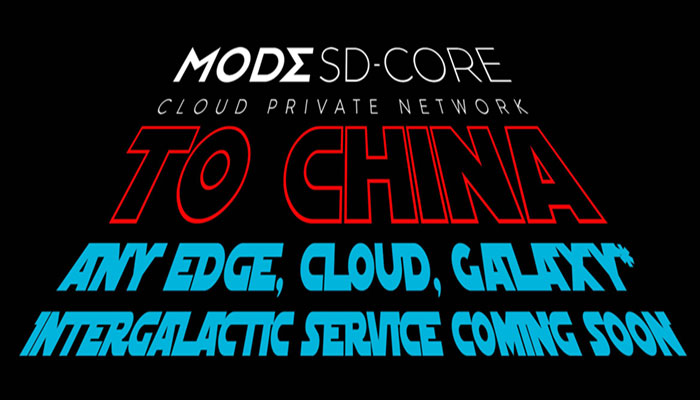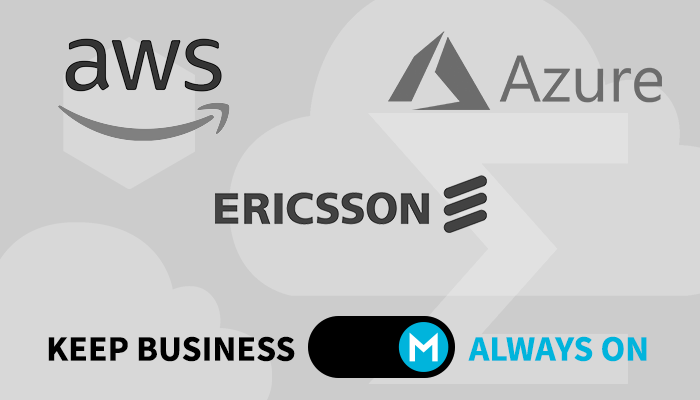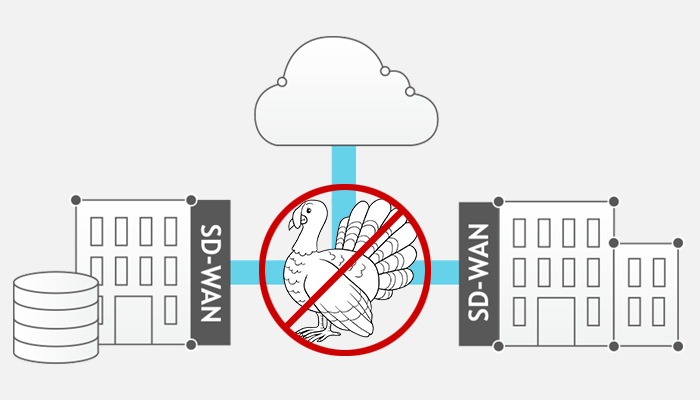Blog
In a network far, far away...
There’s a street in San Francisco called Gold Street, named for the banks that held the spoils of the Gold Rush.
Your gold was safe in those banks. The trick was getting your gold into them without interruption.
Along the way, you might get hit over the head or slipped a Mickey, and find yourself with no gold and a splitting headache on a surprisingly slow boat to China (i.e. being Shanghaied).
Today, there are no banks on Gold Street. You’re not going to get hit over the head going to dinner at Bix. But you’re still likely to encounter something slow to China that leaves you with the same big, bad headache: your network.
China. Business is booming. But connecting to businesses in China remains a huge PITA. There is precedent for good connectivity into and out of China: private networks (MPLS etc.). Tolerated by the government for business purposes.
But the Internet? Not at all. There's a good reason for so many homegrown SD-WAN solutions in China. They work great inside China, but break when connecting China to the rest of the world.
Cloud connectivity is even worse.


Internet data courtesy Cloud Performance Benchmark 2019-2020 Edition from ThousandEyes
What you need is high-performance, high-availability connectivity to and from China that operates near the physical latency limit, and avoids nearly all latency variation, jitter, or packet loss. With the same kind of performance between China and any of the cloud service providers. All with the scale, flexibility, and affordability of the Internet.
You need two things to make this happen:
Thing One:

The Right Provider in China
China has traditionally supported private networks like MPLS for vital business traffic. If you're going to rely on a network connecting you to China, you need to choose the right provider — one with a history of working effectively in China. Not only is Singtel a leading networking provider in China and throughout Asia, they were also selected as the Best Enterprise Provider in the 2019 World Communication Awards. Today, Singtel has extended SD-CORE to three PoPs in China, as well as Hong Kong, Taipei, and Singapore. China is open for business like never before.
Thing Two:
The Right Network for China
We know that Mode SD-CORE is built from Mode Autonomous Fabric, the only autonomously controlled network solution that defines global core performance and delivers it to any edge solution, SD-WAN, or SaaS.
Now, Singtel brings the amazing network efficiencies of autonomous control and SD-CORE to China and all of Asia.
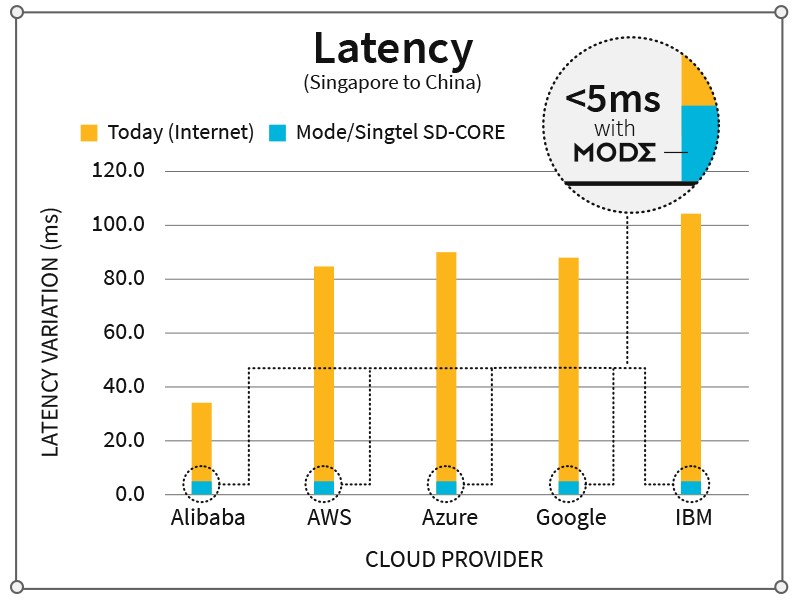

Internet data courtesy Cloud Performance Benchmark 2019-2020 Edition from ThousandEyes
If you need reliable high-performance connectivity to, from, and within China, including CSP private link traffic — for any business, application, or service — SD-CORE is it. The ideal, affordable network at every moment, everywhere.
Learn more about Singtel SD-CORE here.
And may the Fabric be with you.
(spoiler alert: you can't)
Breaking the Internet. It's as old as the Internet itself. The first culprit: web pages. Cacheable content. The band aid: CDN. It worked well, and it wasn’t done. The next major culprit: video of the Netflix variety. Same cacheable content, bigger scale. CDN and done, again.
It's happening once more. Today, it's all about real-time. And CDN won’t be coming to the rescue. We are talking live, interactive video. Major applications like interactive eSports (Twitch and Mixer), or collaboration (Zoom and FaceTime). You can't cache me now, because time machines aren't real like hoverboards.
Network issues — jitter and latency variation in particular — can really wreck the user experience. CDNs can't solve this problem.
Only a better network can. And there are essentially only two ways of delivering this.
Use the Best of Today
The typical solution is to use private transport, at least selectively. This has a few unwanted consequences. First, it's expensive. Either it erodes profitability (for business applications), or it can't sustain the business model at all (consumer applications). It usually forces the application provider to run their own network. All new CapEx and OpEx. Let's slow down those global plans, the network needs to catch up. It's the pain of being what you're not: having to support a major service that isn't your primary business.
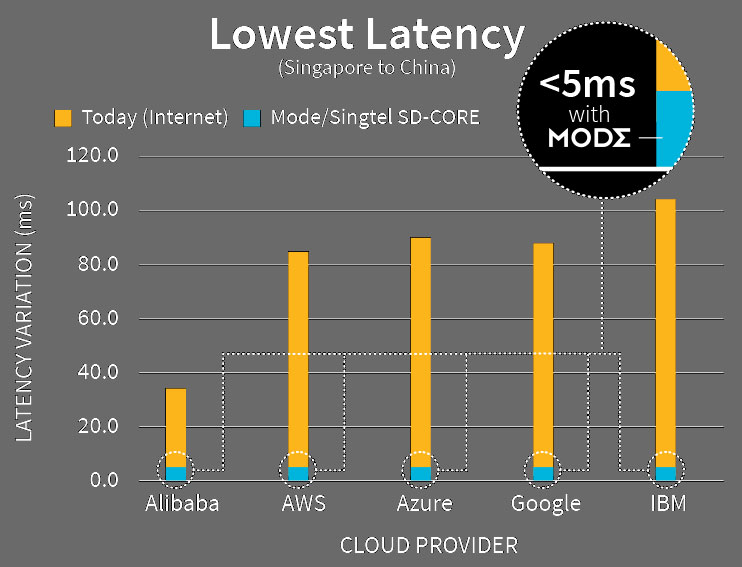
ou can ameliorate most of the "run your own network" issues by choosing among a variety of "managed core networks" that are the latest rage. These solutions reduce the management headache, but use traditional or quasi-traditional networks - both private and public varieties. Private transport still costs. And Internet — even in "optimized" forms that use private PoP networks for "dynamic path selection" — fall far short performance-wise.
Win the Future with Fabric
The real solution is quite simple, at least in theory: take the highest-performing networks in the world - private fiber among them - and somehow make them affordable, without sacrificing performance. Come to think of it, why not improve performance while you’re at it. We’re dreaming here, so why not, right?
Pinch yourself. It's not a dream. Turns out, Tier 1 service providers typically run a LOT of different networks, all using different protocols. Collectively they constitute their “global core.” But the protocols, capacities, and performance profiles of these networks are typically different, and support different classes of customers. These networks are discrete, disconnected. Most of them use traditional hardware-based heuristic routers or inflexible protocols like MPLS to move traffic (the former is known to be very inefficient).
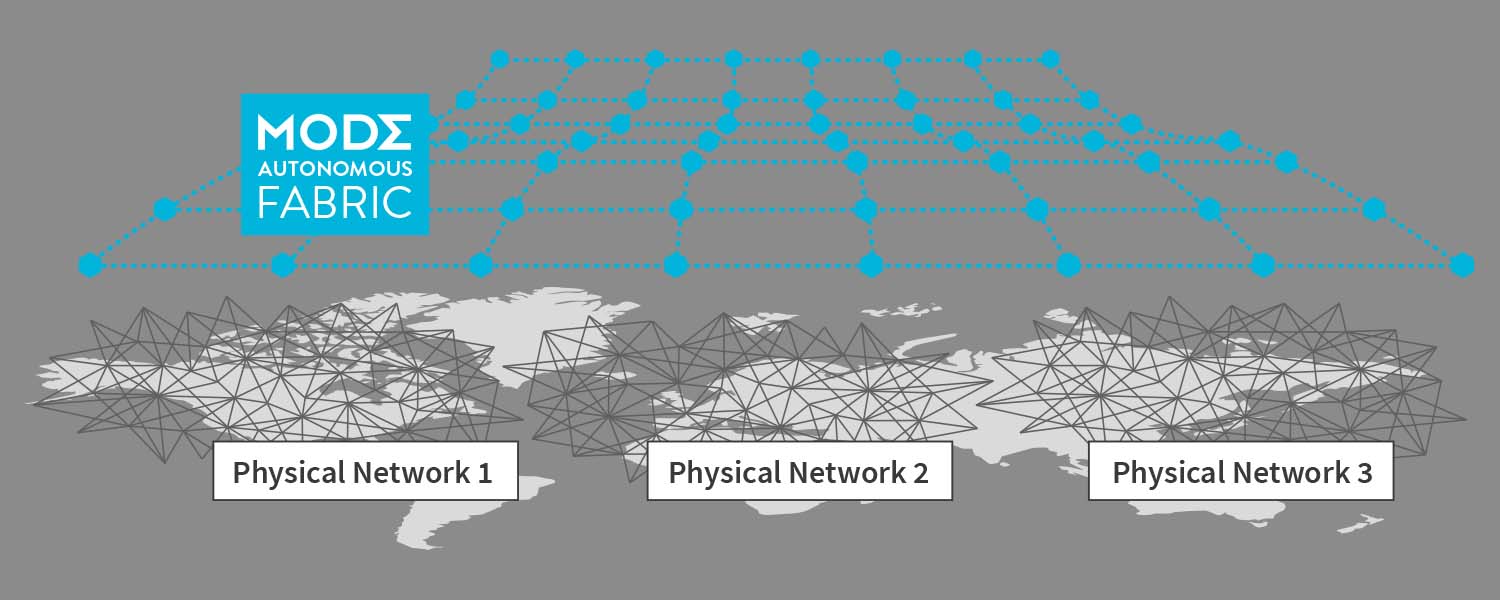
Routing doesn't have to be inefficient or inflexible. Packet routing is a solved problem, thanks to Mode HALO. We build software routers using commodity service provider bare metal hardware (Mode Autonomous Routers). Each router computes the mathematically optimal routing solution every 150ms. Together these routers form a distributed control system — Mode Autonomous Fabric — that increases service provider physical network efficiency, and allows us to virtually unify these networks into a single pool of capacity, with guaranteed QoS and SLAs. Perfect for demanding applications like interactive video streaming. We've used this combination of Fabric and service provider underlays to create Mode SD-CORE, the ultimate private core NaaS for SaaS providers (and enterprises, too).
The combination of increased physical network efficiency and pooling service provider discrete hetero-protocol networks, delivers private link performance beyond anything available today - at the price of Internet transit.
Mode SD-CORE offers the performance needed for business collaboration and video:
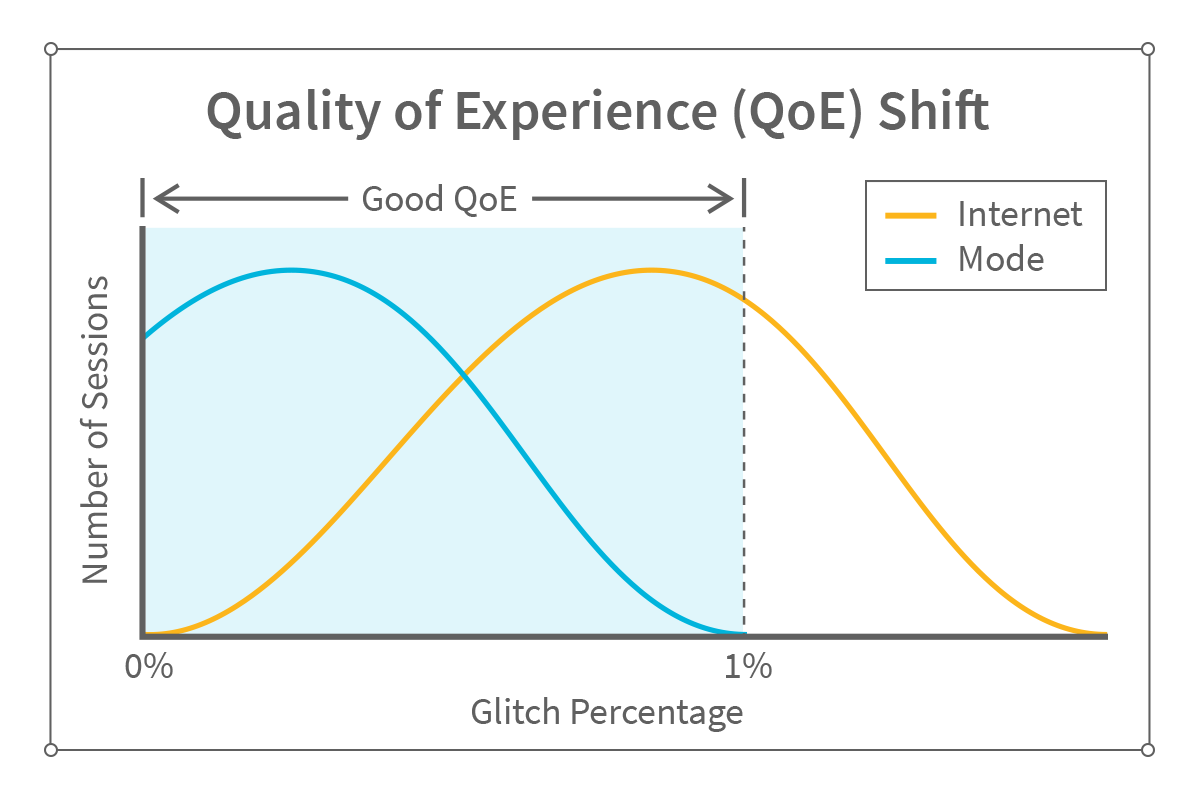
Making consumer applications like eSports work perfectly from anywhere on any device. All this is only possible because the network’s built with Mode Autonomous Fabric.
Mode SD-CORE also enables Interactive Video customers to dramatically reduce application server footprint, and optimize placement of the remaining workloads anywhere in the world.
Mode Autonomous Fabric is changing your future, one service provider network at a time. And people are noticing: Fierce Telecom, November 2019, named Mode a Top 12 Telecom Disrupter.
Want to know more? Download our Mode for Interactive Video Infographic to learn how Mode SD-CORE is already changing the future of interactive video. You can't cache progress :)
SD-WAN: How a Bad Acronym Inspired a Network Revolution
There are currents of speech that simply annoy. I'm certain you know what I mean. Words or phrases that trend and are harder to kill than zombies. I swear if I hear "top of mind" or "at the end of the day" or "empower" or "move the needle," I will flip my bits.
But acronyms rule them all. We all used to enjoy a good acronym or two. Nowadays, every verbose concept winds up with its very own tongue twister. Worst of all, some manage to be both annoying AND misleading.
Case in point: SD-WAN. Software-Defined Wide Area Network. Except it's not.
Not to say SD-WAN doesn't do some wonderful things for your network. It does:
The SD-WAN name implies software-defined visibility and control of the entire WAN, right? Surprise! SD-WAN doesn’t do that, at least not by itself.
True, SD-WANs give you visibility and control of the edge of your network. Also true, they wrap things up nice and tight and ship them end-to-end. But here’s the kicker: the majority of that distance occurs over a backbone network that SD-WAN can’t see or control. In most cases, the core of the network is the Internet, and it’s not “software-defined,” not even a little bit.
A better name would be SD-Edge. But that ship has sailed.
This gave us inspiration to coin the term “SD-CORE” – in the specific context of what SD-WAN does and does not do. SD-CORE is the missing link, if you will, of a real “software-defined WAN.”
The idea was simple – extend the control that SD-WAN gives you (at the network edge) to the core of the network. True software-defined end-to-end control. We see SD-CORE as the natural partner to SD-WAN, working together to fulfill its original promise of software-defined network nirvana.
But what does a global SD-CORE really give you? Some pretty valuable things, actually:
Turns out, Mode isn’t the only one who digs SD-CORE. Singtel has embraced it in their Singtel SD-CORE offering. Even Cisco talks about SD-CORE in this very same SD-WAN context.
Even though we coined the term SD-CORE for SD-WAN, it doesn’t necessarily mean Mode’s is the best.
But it is.
Mode SD-CORE is the market-leading SD-CORE for a good reason: it combines three must-haves into one network — something no other SD-CORE can do:
Mode SD-CORE is Internet-connected, and the easiest way to take Internet Core unpredictability out of the performance equations for business SD-WANs, and ASPs running demanding global applications.
Ready to believe the hype and see for yourself how Mode SD-CORE can make your network dreams come true? It’s easy: just Mode & Go.
Check out our webinar on maximizing cloud performance with SD-CORE.

AND... Take a minute to look over our new Infographic, Mode SD-CORE for Interactive Video
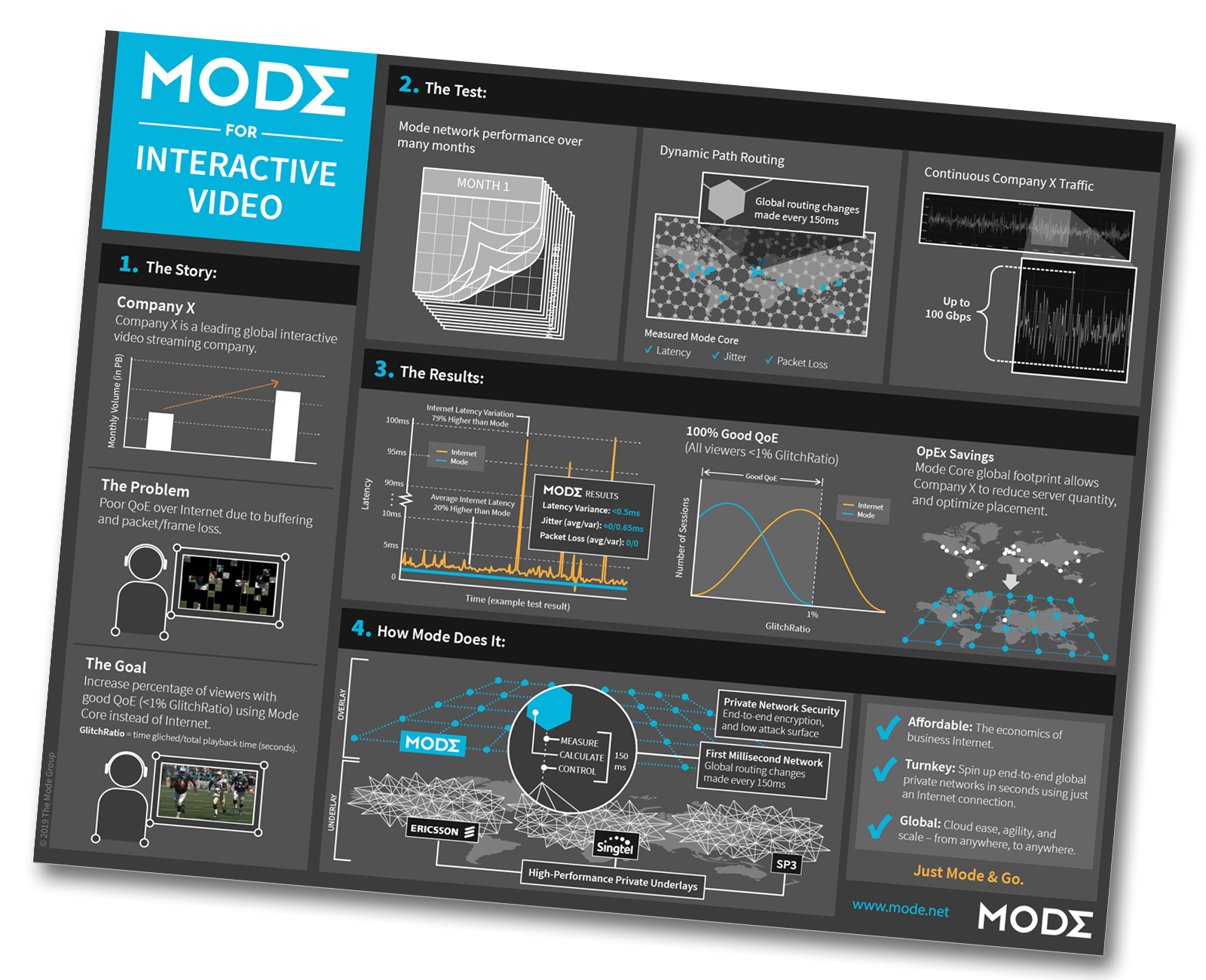
Reliable Start Up. There it is. The oxymoron of early adoption.
Typically, you sweat the bugs in startup technology because the benefits are worth the wait. Before too long that V4 comes rolling out, and you’re vindicated. But reliability out of the gate? Conventional wisdom says no way.
Let me tell you a story about conventional wisdom. When I was a medical student at Stanford, I was on a case with Dr. Vincent R. Hentz, a preeminent hand surgeon. A mentor. I got to call him Rod. I knew the conventional wisdom for applying tourniquets to limbs. Limbs can go without blood for a good amount of time, and bloodless surgery offers superior visualization. Legs, 180 minutes. So I mentioned the 90 minute rule to Rod at the start of a hand case, and he laughed.
"Rules like that are for people who can’t think." He then used that patient's medical record to precisely calculate a time. Lesson learned: conventional wisdom was for suckers.
True then, true now. Turns out, Mode is pretty unique in its ability to call itself a reliable startup. Here's why:
No Pioneer Tax
When you suffer through the early versions of startup solutions, you’re paying a sort of pioneer tax. You're along for the ride, right there with that crafty group of entrepreneurs. It's both exciting and terrifying. I don't know if it was my good friend Searl Tate (former CIO and Managing Director Paul Hastings, an Am Law 100 firm) who coined this phrase, but I certainly learned it from him. In fact, take a look at Searl's guest blog here.

It's true that Mode SD-CORE is the highest performing, QoS-capable backbone network in the world. But the heart of our network consists of tried-and-true underlay networks, managed by trusted providers like Ericsson, Singtel, and a growing list of who’s who from the operator world. Our software uses Millisecond Control to eliminate subsecond problems from these already solid, business-class networks. Even without Mode in the picture, these networks feature reliability and security. We simply drive utilization efficiency that takes performance to unseen levels, and makes it affordable.
In this way, the failsafe position for Mode SD-CORE is a trusted network that's wrung any pioneer tax from the equation many moons ago. This leaves Mode with essentially zero pioneer tax. All that’s left is the upside from transforming some very solid networks into an even better one.
Don't Outsource Your Security

When it comes to security, don't trust us. Seriously. The first rule of Compliance Club is trust no one. Especially not third parties. When businesses use Mode SD-CORE, they maintain exclusive control of their security policies and keys. Everything is encrypted on SD-WAN CPE, end-to-end. Mode is not a trusted party, and we don't need to be.
Other backbone networks require key sharing for performance gains. Not Mode. Mode SD-CORE also offers the low attack surface missing from any public network, like the Internet, or backbones based on private PoP networks that still rely on public core transit.
From a security and compliance perspective, while you can't trust any startup, you don't have to with Mode.
Choose Your SD-WAN. Go at Your Pace.

Then, we let businesses decide how much traffic to move from Internet or MPLS to Mode SD-CORE. Go at your own pace, and only pay for what you use. And if you need to move bandwidth back to other networks, we support that too, with provisioning and management changes made nearly instantly. Try that with your current network provider.
Mathematically Optimal
It's hard to trust anything in this world, but math doesn't lie. Mode SD-CORE is the world’s first Millisecond Network thanks to Perfect Network Control™. This autonomous control solution is based on published math, derived by our founders while at Cornell.

It produces the mathematically optimal routing solution at every node on the network, every 150ms. While we can't make the claim that our network is perfect, our routing is constantly driving bandwidth towards the meridian of perfection. That should go a long way to earning trust.
Great Backers

Mode is backed by the National Science Foundation, who sponsored the original research, and venture firms like NEA and GV, who believe in our ability to create a ginormous market for affordable private QoS backbone networks in this era of "digital transformation." We tend to agree with them.
Great Customers
Ultimately, trust comes from happy customers who have good things to say about your service. Birds of a feather, and all that. We've got some very big, very demanding customers, many of whom run their own networks to exacting standards.

They span a number of industries:
Some of them are quite shy. We think we can coax them into the public eye later this year or early next, so they can tell you more about Mode SD-CORE, and how it has helped take their businesses to the next level.
Until that time, I'd like to leave you with a little something.
Download our latest infographic to learn how Mode is able to take trusted private service provider underlays and transform them into the gold standard for high-performance QoS backbones for the cloud era.
Trust me, your SD-WAN will thank you.
Have It Your Way.
I am simply amazed at the volume of professional acronyms that get tossed around daily on the job. It’s clearly some sort of currency of credibility.
I come from the world of medicine. No shortage there. LOL in NAD – know what I mean? Exactly. We even use different words for things that already sound legitimate. For example, urination. You think? Nope. If you're a doctor, it's micturition. We simply can't speak the same language as outsiders (side note: I just used the word "urination" in a blog about private networks :) ).
In the world of enterprise networking, it’s no different. So many acronyms.
Oh, yes, OSI.
The more I think about it, the more I realize that most of what we do at Mode is about flexibility and choice for our customers re: their network. In fact, I can think of seven ways Mode does this. That happens to be the same number of layers in the OSI model. And while Mode applies its technical magic solely to layers 2 and 3 of OSI, we provide all SEVEN layers of what I am now calling **the Mode OMG! Stack**. What are they? I'm glad you asked.
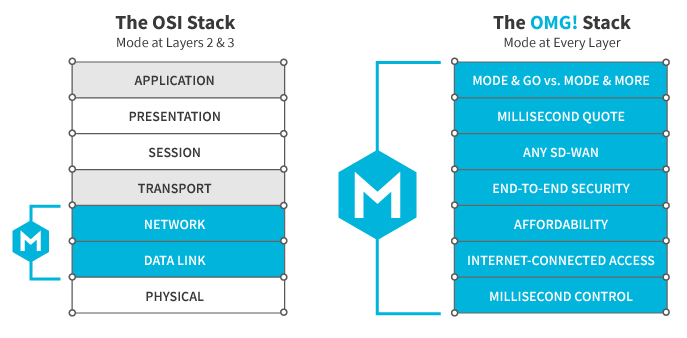
Layer 1: Millisecond Control
Mode's dedication to flexibility starts at the packet level. What could be more flexible than a private network that makes global, node-level routing changes every 150 ms? That responds to dramatic traffic disruptions like a faster, smarter, cooler version of Neo (cmon, The Matrix). You know the phrase "bend but don't break?" Millisecond control is like that. Bits must always flow. Autonomous control means that, no matter how Byzantine the network, we will find the way. And not just any way. The best way.
Layer 2: Internet-Connected Access
Is it a crime to need a private network, only to have to wait months to get it installed at your office? We think it should be. Mode SD-CORE is Internet-connected. That means you already have everything you need to connect to the highest-performing private network on the planet in just a few seconds. That's incredibly flexible.
Layer 3: Affordability
What good is easy private network onboarding if you can't afford to use it once it's running? Having to pick and choose which apps and data to run on your preciously expensive private network is the definition of inflexible. Not with Mode. We begin with high-performance private underlays from our service provider partners. Then we do something amazing: we make them more efficient with autonomous control. And that efficiency translates into even better performance, and remarkable affordability. How affordable? The price of business Internet. Not having to choose which app, what data - that's our gift to you.
Layer 4: End-to-End Security
Some software-defined cores (backbones) require you to share your security keys with them to achieve their performance gains. We think that’s a bad idea. That should be your choice. Mode believes that control of security keys and policy should stay exclusively in the hands of our customers. Need end-to-end security via SD-WAN encryption? We support that. Want to direct your data to a VNF for this or that? We support that, too. Again, flexibility.
Layer 5: Any SD-WAN
At Mode, we are experts of Core Control and the private performance Core. We leave things like Edge Control to our many partners. Some Core providers force you to use their homegrown SD-WAN to get access to their backbone network. We think that's a bad idea. Choosing between market-leading SD-WANs and the highest-performing cloud private network in the world? That isn't right. Good news: you don't have to. Mode SD-CORE works seamlessly with ANY SD-WAN. The one you have, or the one you want. We've got your back.
Your Last Mile and SD-WAN, Enhanced with Mode SD-CORE

Layer 6: Millisecond Quote
When you're interested in taking your SD-WAN to the next level of performance, you don’t want to wait around for weeks to get a quote. That’s why we are building the Mode Millisecond Estimator. It’s based on advances in technology beyond the scope of this blog. But it will give you an estimate for your custom-created network topology within milliseconds of clicking the “submit” button. Try that when you want a quote from your service provider. We’ll wait.
Layer 7: Mode & Go vs. Mode & More
Finally, we've reached the top of the OMG! stack. And it's way up here that you'll find the last piece of the puzzle – flexibility in purchasing.
Say you've got last mile and SD-WAN at all your branches.
We've got you covered. Just add Mode & Go.
On the other hand, let's say you're shopping for the best SD-WAN, and you need last mile around the world to boot - AND the highest-performing cloud private network the earth has ever seen?
We and our Partners offer all of that with Mode & More.
So no matter how you want to get your Mode on, we're sure we can make you happy.
There it is.
The Mode OMG! Stack
Why OMG!? Because that’s what you'll say when you see how simple Mode makes quoting, deploying, operating, and affording a reliable high-performance Private Performance WAN. Considering that, I think we're all OK adding this particular acronym into the networking lexicon :)
Looking to learn more? Check out our upcoming webinar.

And check out our latest OMG, we won!
Pretty good clickbait, huh? Hard to make any sense of it, but just enough to draw you in to find out what's what. I promise you, it will be worth it.
Truth is, I never expected this bizarre title, or to be writing a blog inside a car wash.
Yet here we are. Now, the typical car wash takes about 45 seconds to run. I'm a pretty quick writer, not that quick, but I'm not worried.
Because I'm stuck. Not moving. And no idea when I'll be getting out. How did this happen? Here's the backstory:
I've taken my vehicles through this bad boy over 1,000 times and it's never broken down. Not once.
When I saw today's schedule, I saw opportunity. A quick run through the car wash before my call with Ted @Gartner would still give me 15 minutes of buffer. Sweet.
So I pulled the trigger.
And now, I'll be talking to Ted inside this damp, dark tunnel (sorry Ted, you're a good sport). The ultimate example of just rolling with it. So, if you'll excuse me for a moment ... "Hey, Ted? ..."
So, where were we? I can feel a metaphor coming on. Let's try this: things you rely on work, until they don't. Like my car wash. Or your business network. Usually, at the worst possible time.
I'm not an expert on MTF's and car washes, but I know a little bit more about networks. And if you're relying on the public internet as backbone for your SD-WAN and business connectivity, it’s only a matter of time before the unexpected puts a ginormous wrinkle in your business plans. Being struck in a car wash will look like a fun Disneyland ride in comparison.
So let's talk about network problems. The vast majority of these problems are related to the common metrics we've all come to dread: latency variation, jitter, and packet loss.
But what most people don't know is that the majority of these problems come and go in under a second. That's right - one second. Let's visualize:

Now, if this curve represents the problem distribution of a public network, like the Internet Core, then private networks like MPLS would have a problem curve like this:
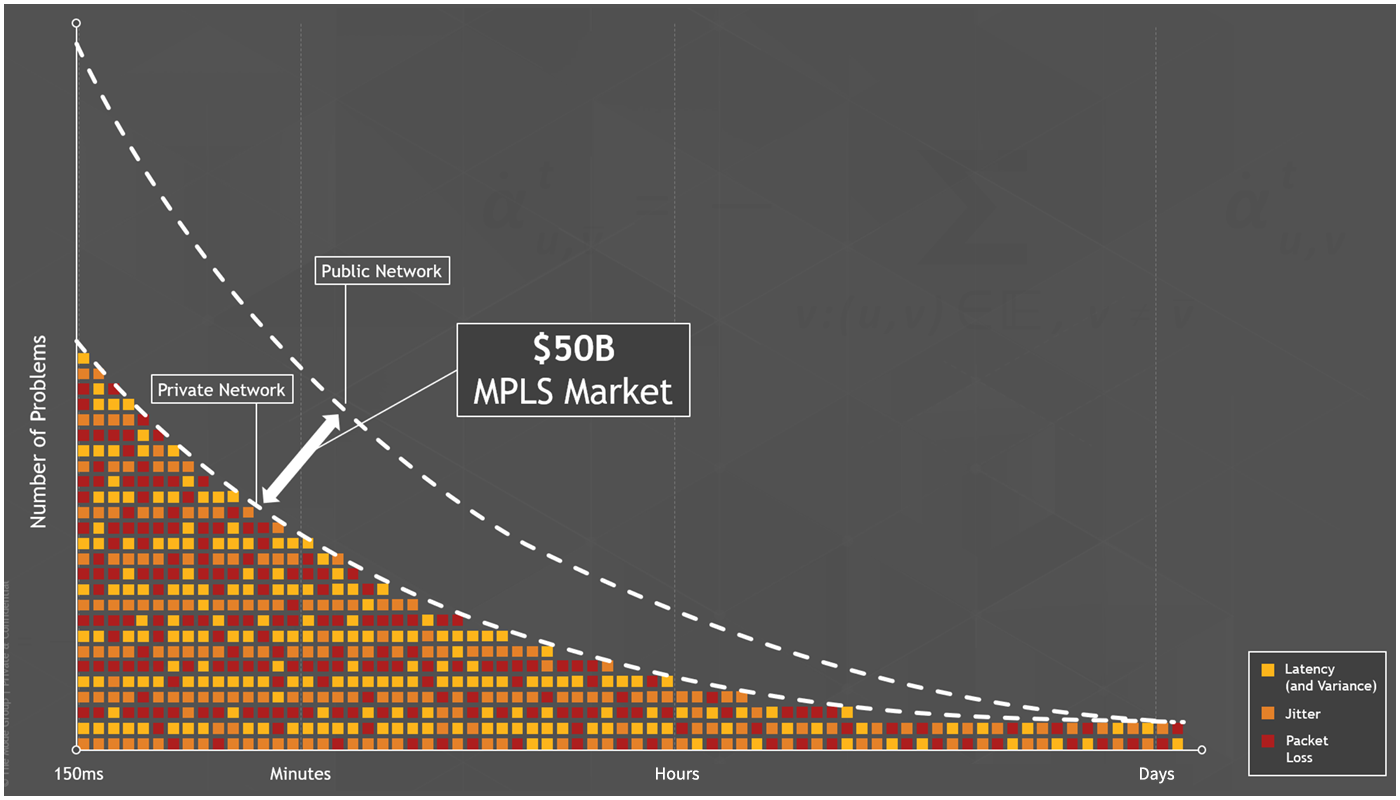
The difference between these curves, and the corresponding reduction in network problems, is essentially a visualization of the $50B private network / MPLS market.
Of course, these problems don't go unnoticed. Network operators try to identify and correct them. But their ability to correct them in time is the key differentiator.
Telcos, for example, are used to identifying and correcting problems that persist for hours or days. Their control techniques make detection and correction of more fleeting problems untenable.
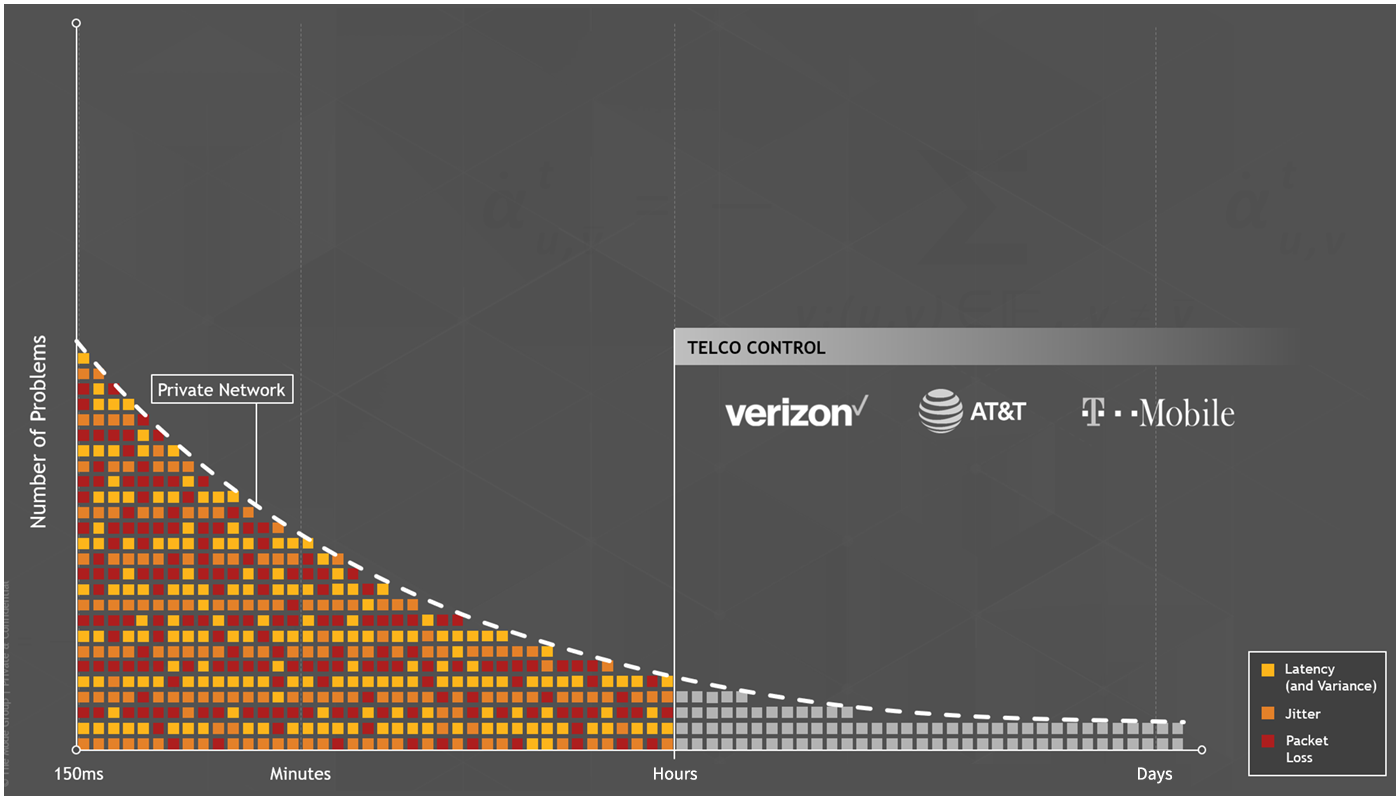
Webscale companies up the ante with more responsive control, designed to address network problems that persist for minutes.
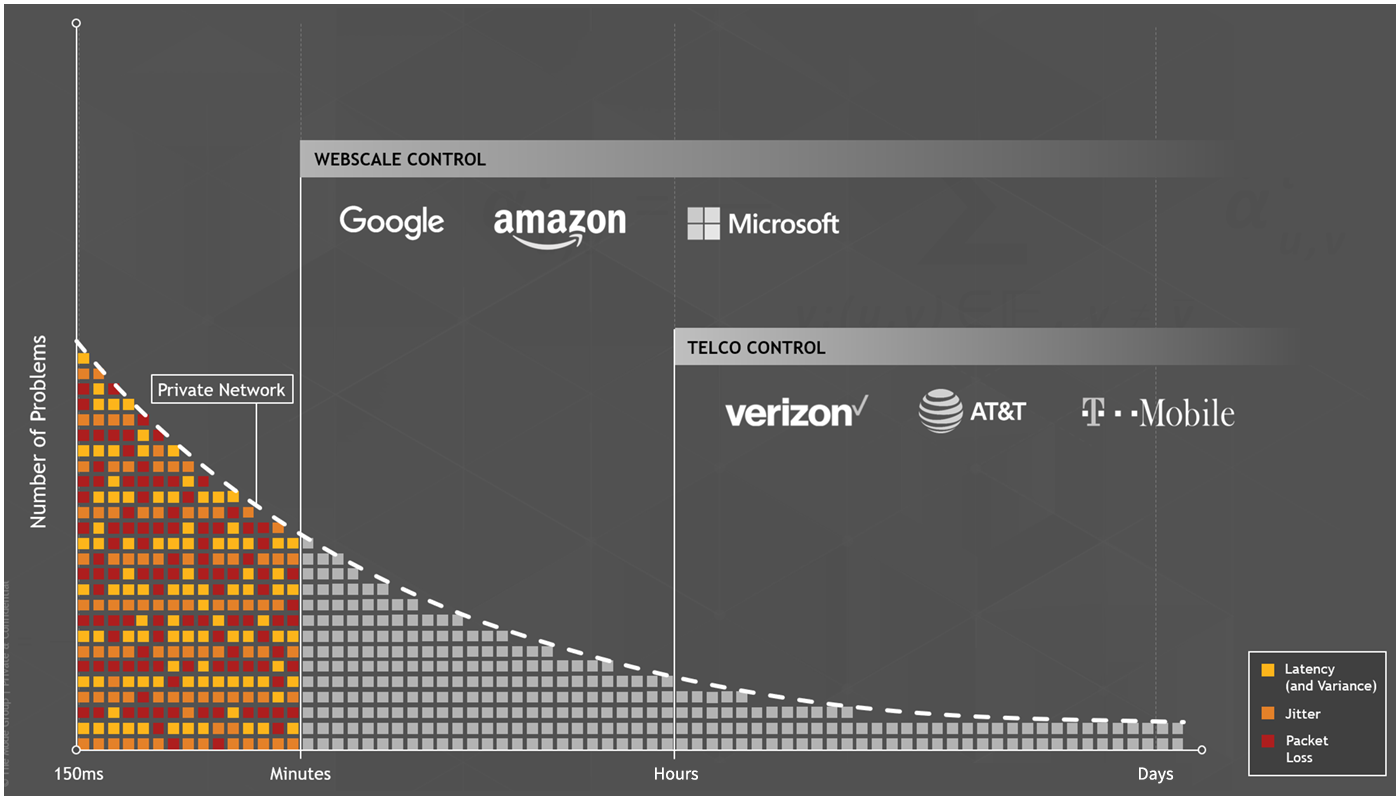
Unfortunately, neither Telco nor Webscale control methods are able to address the big mountain of problems in the sub-second range – the ones that keep glitching your videoconference, dropping your effective throughput, and making your SaaS and multicloud access hiccup and crawl.
That's why we built Mode. Mode Perfect Network Control™ measures, calculates, and controls the perfect network solution every 150ms. So we identify and optimize around nearly every sub-second network problem. Other networks can’t even come close.
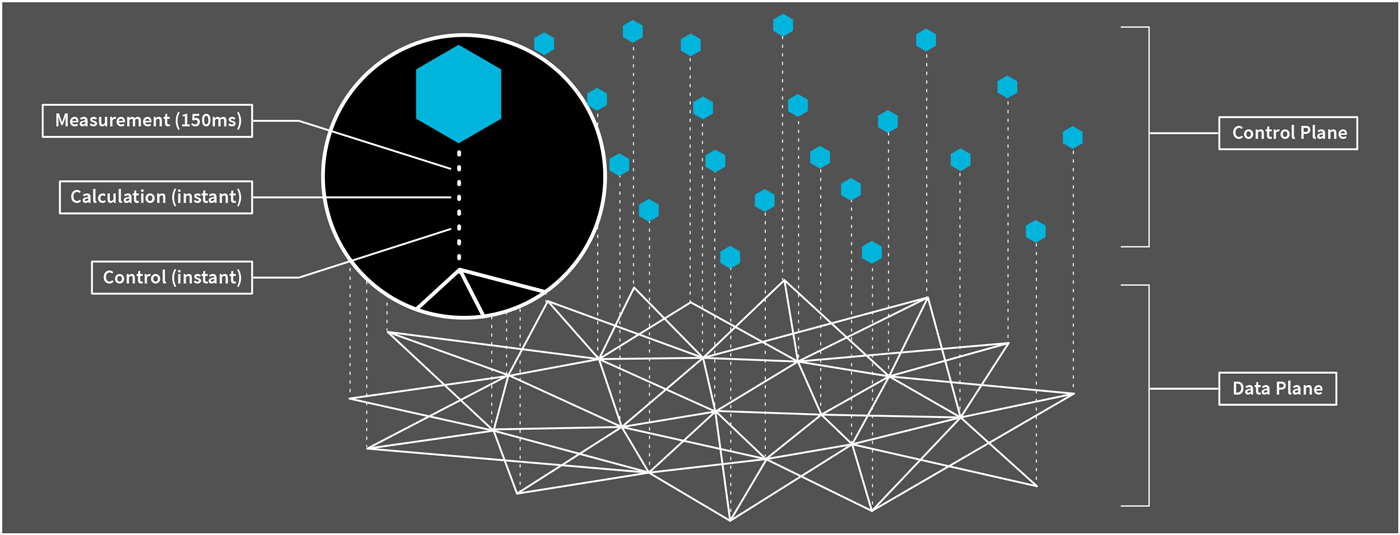
Getting rid of all those sub-second problems means achieving a level of performance previously unseen in a private network, never mind a public one. High-performance for branch access, SaaS, hybrid, and multicloud, MPLS backup, video & voice, large file transfers, and more. But how we do it means you don’t have to pay a fortune for this kind of performance, either.

Mode SD-CORE's private network performance is available at an affordable business internet price precisely because we solve network problems that come and go before other network operators even know they exist. Our networks run much more efficiently, and we pass that savings on to you, our customer.
Control is fundamental to network performance. Other performance techniques like WANOP are like cherries on the sundae. You need to start with fundamentals. The control bar has been moved to milliseconds. If your network can't move that quickly, your business and your SD-WAN are leaving performance, money, or both on the table, every time. I'm still in this car wash. And I’m beginning to wonder if I'll ever get out. Don’t be like me.
If you're responsible for keeping your WAN Always-On, bad networks might put your job at risk.
Mitigate your network exposure. Get the best out of your SD-WAN. Live the No-Worry Network life. Contact us today, it's time ... to Mode and Go.
When it comes to networks and SD-WAN, businesses have an increasing number of options. And with that comes a whole lot of confusion.
Most enterprises see this world in two colors: last-mile (Internet) or Private Network (MPLS).
It's pretty common to call these last-mile connected networks "Internet" or "Internet-based" but that can be pretty misleading. The only thing that necessarily makes them "Internet" is their use of a last-mile connection to your SD-WAN.
Beyond the last mile, solutions range from Internet Core (the only true Internet network in this case), to Optimized Internet, to Private Networks. Yes, private networks that connect via last-mile, and perform like traditional private networks.
We all know that MPLS offers private-network performance. At a great cost. And often, great pain (operationally speaking).
We also know that these "Internet-based" networks that connect via last-mile to your SD-WAN are the future. So, in thinking about your future, here's the question of the day:
Do differences among these Internet-based networks matter to most businesses? To your business?
It's already been shown that last-mile Internet can be part of a reliable, high-performance enterprise WAN. Redundancy functions in SD-WANs makes this even more true. It's also been shown that most performance variability, e.g. latency variation, happens in the core (>99%), and not the last mile.
We know that when it comes to cloud-evolved businesses that rely on hybrid or multicloud, SaaS, long-distance collaboration, etc.- milliseconds matter. For example, a single millisecond difference between financial networks can cost an institution $4M. A 1Gbps connection with 30ms of latency has 17.4 Mbps of effective throughput. At 50ms of latency, audio gets choppy. At 80ms, video goes the same way. Amazon loses 1% of sales for every 100ms of network latency. And SaaS usage drops by 8% every 200ms.
The ultimate comparison of Internet-based networks would be a study of performance extremes: poor, plain old Internet on one hand, and an Internet-connected next-generation private core on the other. It’s not fair.
So we did it anyway.
Download our Public vs. Private Infographic.
Designing a meaningful study of public versus Internet-connected private network performance in the context of the modern hybrid Enterprise poses significant challenges. The unpredictable nature of the Internet, combined with its massive scale and rapidly-changing peering structure, complicates quantitative comparison. Measure too little for too short a period of time, and the data may be anomalous.
We overcompensated. Working with our service provider partners, we collected 320+ million data points over four weeks, among 32 last-mile locations, 24 cloud instances, two cloud providers, and four continents. We are proud of the result: a study of substantial power.
The results of this extensive research will be published shortly as The 2019 Public vs. Private WAN Performance Comparison. Which is really a comparison between Internet and an Internet-connected private network for your SD-WAN. Both share the last mile. The core is where they differ.
If you were to ask me at this time how it all turned out, it might go something like this:
You: Hey, Adam, are you certain that using an Internet-connected Private Network for my SD-WAN can really help my business.
Me: I am not uncertain (thanks, Dollar Bill)!
 But let's not beat around the bush. You can take a look at our one-page results summary and decide for yourself. And if you're really curious, we might even let you peek at the entire paper. We will cover the details further in a future blog.
But let's not beat around the bush. You can take a look at our one-page results summary and decide for yourself. And if you're really curious, we might even let you peek at the entire paper. We will cover the details further in a future blog.
Tune in next week to learn what my car wash and your enterprise network have in common. Hint: It's got nothing to do with Armor All.
How Network Performance Batters Your Bottom Line
We all know that bad networks with high latency, latency variation, jitter, and packet loss lead to user frustration – leaving your workers, and your customers, unhappy. Which leads to low usage and churn. Then lost opportunities, and lower profits.
If you're responsible for keeping your WAN Always-On, bad networks can give you worse sleep, and maybe even put your job at risk. So when we say that Mode is the No-Worry Network for your SD-WAN, how do you really know? When you look at that SLA and those performance guarantees, how does that really translate into performance, and how does that performance actually tie into profitability? Stick with me, dear reader, to find out.
Obviously, this is a pretty complicated series of questions. Time to give it some quantitative color.
Metrics and Technical Impact
Let's start with the network metrics that matter. Latency and its Variation, Jitter, and Packet Loss. Each of them can drag down performance - from standard web applications, to real-time applications, to bandwidth-intensive applications like backup and recovery. Some research even suggests that cloud service pricing is causally linked with these metrics. But their impact is different depending on the use case. Let's look into that.
Real-time Applications
Example: VoIP, videoconferencing
Also: Twitch/Mixer, Real-time Workloads, IoT Streams
Let's consider communications applications, like VoIP and videoconferencing.
Latency
Latency itself doesn't affect the quality of the delivered audio, but it can ruin a good conversation. At 100ms of latency, people start talking on top of each other. At 300ms, the conversation becomes unintelligible.
Latency Variation
High latency variation is behind all those gloriously bizarre glitches that always seem to happen during the most critical part of a meeting. Hey, Adam, you sound like a robot underwater. Can you try a different network?
High latency variation can even lead to dropped packets when those packets arrive with excessive delay, causinge the worst glitch of all - the dropout. I'm sorry Bob, we can't hear you. Can you check your headset?
Packet Loss
Real-time communications are typically UDP-based, and for the most part the Internet and its routing designs treat UDP (and other small packet protocols) as second-class citizens. UDP packets are more likely to get dropped as a result of deprioritization. This, and drops due to timing errors and other causes, result in missing conversation and collaboration data, and more dreaded dropouts.
Quantitative to Qualitative
Collaboration application performance is often graded by the Mean Opinion Score (MOS), a universal metric to measure and classify the quality of VoIP and videoconferences. It ranges from 1.0 (low) to 5.0 (high) with 3.0 deemed the very limit of acceptability. For each 100ms latency, the MOS score drops by one point. Since 150ms is the limit of physical latency for a round-the-world trip, you can see how very long distances automatically put the quality of voice and video at risk, starting at 3.5. Just 50ms of added latency puts the conversation below the threshold of acceptable performance.
For example, a long-distance video conference with a physical latency limit of 100ms, needs only 100ms of added latency, or 50ms of latency variation, to put the collaboration session below the line of acceptable. In real-time, every millisecond matters. Which is another way of saying the network matters, a lot, for real-time application performance.
Even though we're talking voice and video, the effect is essentially the same for all real-time applications, one of the fastest-growing segments of enterprise applications. Real-time collaboration and workloads. IoT streaming. Highly distributed data requiring fast assembly and analysis.But what about other Enterprise use cases?
Standard SaaS
Modern SaaS application performance deteriorates steeply with latency variation beyond 80ms, and packet loss beyond 0.5%.
Backup, Recovery and Large Files
Both backup and recovery are bandwidth-intensive, sensitive to latency variation beyond 25ms and 10ms respectively, and packet loss beyond 0.75% and 0.25% respectively.
So while latency, latency variation, and packet loss are all killers for real-time application performance, they can affect other SaaS and IaaS performance just as easily.
Business Impact
Example: Mixer
Guess what? When you use the best-efforts Internet with your SD-WAN, you put your business at risk. Why? Performance and Security. Learn more about Mode security here.
According to a recent study (with over 320 million data points collected over four weeks, among 32 last-mile locations, 24 cloud instances, two cloud providers, and four continents):
Latency, latency variation, and packet loss can crush all types of SaaS and IaaS performance, battering your bottom line. Mode is the No-Worry Network for your SD-WAN, letting you stress less and do more – BECAUSE we keep your WAN metrics far away from the danger zone.
Best of all, we can get your SD-WAN out of the danger zone in under sixty seconds. All you have to do is ask us how. And that's got to help you sleep better at night.
Take a look at our Mode SD-CORE for SD-WAN here. Please reach-out to Mode here if you have questions on the material in this post or wish to engage with Mode soon.
The Gold Standard Needs Polish
Everyone reading this blog has lived long enough to see records broken. Giants laid low. Things thought impossible, made commonplace. Gold standards surpassed and forgotten. In the modern era of business connectivity, MPLS has been the gold standard for quite some time.
A real 90's throwback that everyone knows has stayed around a bit too long, like melted Vanilla Ice. And yet, MPLS use is growing, year over year. The truth: exploding bandwidth, combined with inertia, is camouflaging an otherwise declining tech.
The stake through the heart of MPLS will be alternative solutions that are faster, better, cheaper. SD-WAN is the tip of this sharp instrument, and SD-CORE the follow through. It won't happen overnight. It will be a gradual realization of parity, followed by a soft coup. It's already well on its way.
It began with this question: is MPLS really as good as it gets?
There are already whispers among CIOs about things like underwhelming MPLS performance, or lapses in virtualized tenant separation, hence privacy. But leave it to Steve Garson and the folks at SD-WAN Experts to ask this blunt question: if an SD-WAN and an MPLS connection have the same bandwidth, which offers better performance?
To answer this, they examined a manufacturer considering a switch from MPLS to SD-WAN, starting with a branch in Latin America.
On the MPLS side, they found occasional routes with latency variations up to one-tenth of a second, inferior performance indeed. This could be due to policy. Or it could be related to the fact that no service provider has a true global MPLS network — it's assembled through business relationships with countless regional players, often with unpredictable results, perhaps including this one.
SD-WAN Experts then examined specific routes between the US and either Costa Rica or Mexico. In the case of Mexico, MPLS scores were significantly poorer than Internet. In fact, on these routes, at that point in time, the Internet had 66% less latency variation than MPLS.
Of course, this isn't usually the case. MPLS is generally reliably good (so says the SLA and the nosebleed pricing), and the Internet is ... unpredictably good (or unpredictably bad). Or simply, unpredictable.
One thing is clear: you need network redundancy to deliver true high availability. Even MPLS, on its lonesome, is no longer a safe bet.
Let's consider the mechanisms of redundancy. SD-WAN offers last-mile redundancy. That's a good start if you use it.
When it comes to the core, the wise company also seeks redundancy. For example, rather than backup MPLS with another MPLS connection, consider using an SD-WAN with a high availability software-defined backbone. It could make all the difference, and save you a lot of money to boot.
Many Internet Core alternatives have different flavors of redundancy baked right into their designs. Optimized Internet approaches use POPs to probe various opaque public IP paths, slowly switching among them based on performance guesstimates. A sort of redundancy, albeit limited and crude.
The ultimate form of redundancy would be to roll up every network on earth under a perfect, autonomous control overlay. Not only would you benefit from the entire pan-global capacity, but you'd also have software scouring all those connections for the one, optimal path for your traffic, every 150ms.
Mode does not control every network. Yet. :) But it does have a perfect autonomous control overlay. Mode SD-CORE capacity starts with a global underlay provided by Ericsson and nearly 100 service providers, and it grows with each SP underlay we add. No limits. An autonomously controlled network with massive capacity offers the ultimate form of redundancy — the fastest possible combination of measure, calculate, and control, routing packets around any obstacle, tripling effective network utilization. Finding the right way, at just the right moment, considering all available options.
MPLS may not be the universal gold standard we thought it was. That's ok, we can all live with that. It's worth it, should it help us recognize the peril of putting all our eggs into one basket.
It's time to diversify. Go ahead and backup that MPLS! Redundancy is our friend, and SD-CORE is a big step towards a No-Worry Network.
You can read Steve Garson's original piece here. Make sure to come back next week for another take on the need for redundancy!
If your business relies on applications and infrastructure running in the cloud, you know how much reliable, high-performance connectivity contributes to the end user's quality of experience.
For Enterprises, SD-WAN provides last-mile reliability, cloud orchestration, and IPSEC-based security and privacy.
But in its most basic form, SD-WAN does little to ameliorate the effect of best-efforts internet and its unpredictable interference with a stable SaaS and IaaS quality of experience (QoE).
Of course, there are exceptions. Talari Networks failsafe SD-WAN, for example, works with Mode SD-CORE to provide reliable, high-performance multi-cloud access. You can hear more about this very subject by tuning in to our webinar featuring Talari/Oracle CMO Andy Gottlieb:
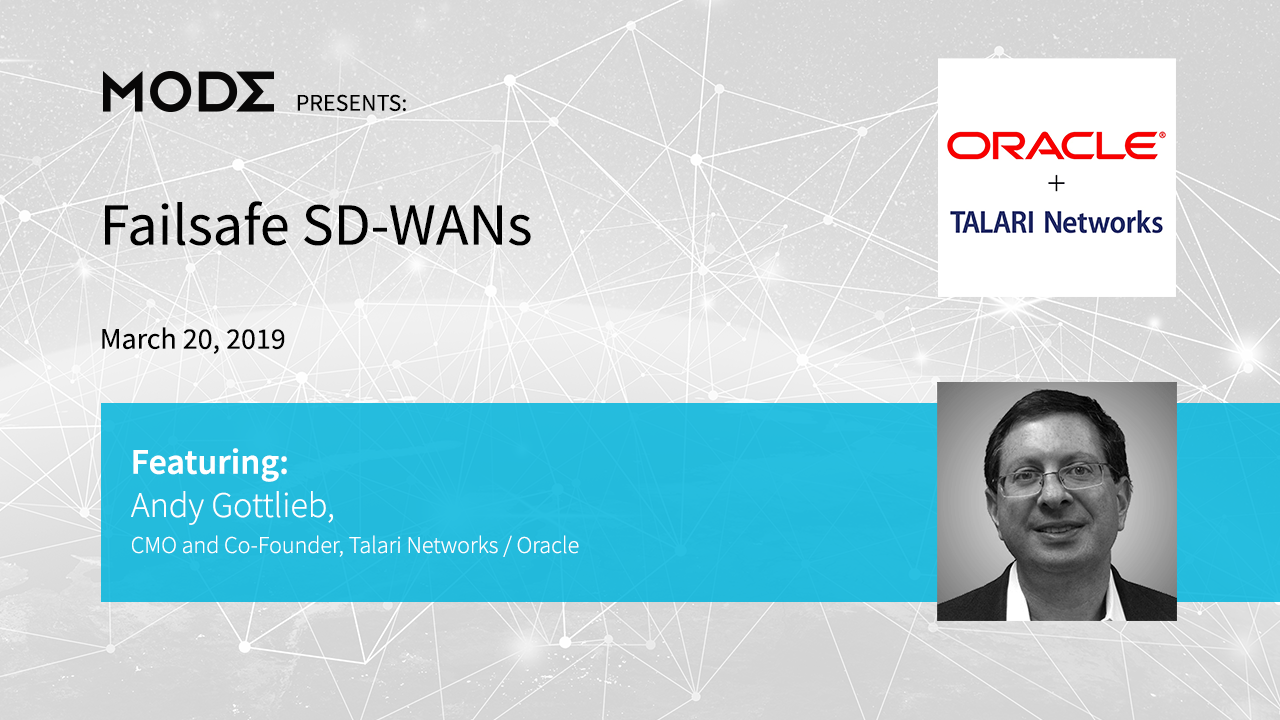
If you're in the business of cloud-dependent applications — from unified communications to multiplayer gaming — you've historically had to make a tough choice: live with the unpredictable nature of the best-efforts Internet, or roll your own network and assume network infrastructure commitments and operations management. Having to become a network operator when it isn't your core focus isn't much fun at all.
We aren't the first to have this epiphany. Back in 2016, our friends at Riot Games wrote about this exact topic. What they didn't know at that time was that work was already underway on a new, autonomous algorithm for packet network control that would change the game of reliable networking forever. Pun totally intentional. More about that later.
Riot Games complained that that Internet just didn't cut it for real-time applications. That's certainly true — and it covers games, voice, video, and pretty much the gamut of what's coming, application-wise. But the Internet is also problematic for mission-critical long-haul business traffic, large file transfers, and traffic requiring high security and a low attack surface.
When it comes to SaaS and IaaS performance, you need three things to guarantee high QoE: a. high-performance private connections to the major cloud services, b. high-availability, high-performance round-the-world connectivity between end users and these multi-clouds, and c. affordability, without which the applicable business cases become vanishingly small in number.
We built Mode SD-CORE to be the ultimate No-Worry Network for cloud access. Mode SD-CORE's software overlay uses Perfect Network ControlTM to drive underlay fiber networks from Ericsson and nearly 100 major service providers toward an optimal state, every 150ms. The end result is the fastest possible path for your traffic, with the lowest latency variation, and the fewest dropped packets — with control efficiencies delivering this level of private circuit performance at a fraction of the typical price.
Mode SD-CORE's capacity grows with each mature service provider underlay added to the global fabric, and Mode's overlay delivers the final word on autonomous packet control — so there is no "pioneer tax" when you go with Mode. Mode SD-CORE peers worldwide with all the major cloud providers, including Amazon Web Services, Microsoft Azure, and Google Cloud Platform, giving you the benefit of an affordable, high-performance private connection to these cloud services.
The end result? A No-Worry Network that makes your SaaS and IaaS investments shine, your customers happy, and lets you focus on your core business vs. network operations.
So while Mode SD-CORE may be the best thing you can do for your SD-WAN this year — if reliable, high-performance cloud access is the ticket to keeping your customers happy with your cloud-based applications, we're the No-Worry Network for you, too. Give us a shout today!
A few months ago, David Hughes, CEO of Silver Peak, wrote a piece titled "2019 Predictions: the Year of SD-WAN."
I read the article and liked it so much that I snatched it back and held it with my GTD (shout out to Todoist, and Buddy Guy) for a future blog. Thanks, David!
This is that.
If 2019 is the year of SD-WAN, and also the year to bet your career on Mode, we are going to have a wild ride. Mode was built to help SD-WAN achieve its ultimate potential, after all.
Your Network Is Showing
The article begins with a bit of a wet blanket: "... despite experts estimating that up to 70 percent of applications have moved to the cloud, the transformational promise of the cloud has fallen short of the hype and expectations ... 85 percent still say they are still years away from fully realizing the benefits of the cloud, citing monthly cloud application disruptions and networks that can't keep pace with demands."
Sounds like the world needs a better network between SD-WANs and clouds, not just a better SD-WAN.
Edge control — the kind delivered by SD-WAN — is great, but it was only a matter of time before promises and expectations met reality: if the core, or backbone, isn't reliable, isn't predictable, isn't secure, and isn't adaptive, SD-WAN devices on the network edge can't deliver the kind of WAN CIOs need. Why? Application disruptions. Networks that can't keep pace with demands. Mode was built to enhance any SD-WAN by addressing what others had neglected — the majority of the network: the core. Bringing incredibly fast, autonomous control to the core. That's the name of the game.
But it doesn't end there. Let's continue with a few more of David's 2019 predictions:
SD-WAN Market Consolidation
Sixty SD-WAN vendors, and counting. This is, perhaps, the most obvious of his points. Folks are making their choices — Cisco bought Viptela and Meraki. Oracle grabbed Talari. And so on. It's musical chairs with only a few seats left, and … hasn't that song has been playing for a while now? How about making your SD-WAN stand out? Future-proof it with a reliable SD-CORE. Make reliable, secure, flexible high-performance HA WAN a lot easier to achieve. Think about it.
Basic SD-WAN Solutions Fall Short
This is a bit of a corollary to the previous point. The basic SD-WANs that lack a rich feature set or (hint) a reliable SD-CORE — that ensures end-to-end zero trust security, MPLS+ guaranteed performance, and a business internet price — are likely to be the ones left standing alone when the music stops. Don't be that guy.
Enterprises Shift to a Business-first Networking Model
Now things are getting interesting. Business-first sounds a lot like intent-based networking. I actually like Business-first better (thanks David). Sure, it's aspirational, but it's clearly where things are going. The network needs to conform to the needs and speed of business, not the other way around. And this has certainly NEVER been the case. Ask any CIO about the carrier train and how much they'd like to get off it once and for all. And while a great SD-WAN can get you part of the way there, you need a great SD-CORE working with it to really make this happen. Why? Because a great SD-WAN connecting to apps, clouds, sites, etc. through rigid MPLS or Basic Internet, or even Optimized Internet, isn't going to be good enough. For end-to-end security. For application performance, in particular those using real-time protocols. For fast, hyper-segmented private global network creation. And for dynamic bandwidth needs featuring wild, instantaneous swings. The dream of Business-first can only come true when affordable, reliable network performance is able to turn on a dime before that business intelligence is out of date. Mode SD-CORE is the only SD-CORE with control changes made at every node, in parallel, every 150ms. No global network on earth can react faster to the changes expected of it. That was always our intent.
SD-WAN and UCaaS Come Together
Voice. Video. Grand daddies of real time. Lag is a drag. If SD-WAN customers, as David writes, "expect [that] the quality, availability, and reliability meets or exceeds their traditional telephony solutions" those UC sessions had better be using something other than BGP-backed Internet or even Optimized Internet for long-haul transport. Almost all of the UC providers have already learned this. That's why many of them have been forced to become something they never wanted to be: network operators, burdened with building their own global backbones. That's tremendously bad for time-to-market and margins. There has to be a better way: a private global network as a service that's ready to take any application based on real-time protocols up to — and beyond — "traditional telephony solutions" performance levels. For a fraction of the cost of any of today's private networks. All possible because of the efficiencies derived from autonomous control. Perfect Network Control™. Only available in Mode SD-CORE.
WAN Segmentation — Key to Securing the Enterprise
If segmentation is a key to Enterprise security, Mode has you covered (working with your SD-WAN of course). First, we feature a low attack surface global backbone, based on underlay networks from Ericsson and nearly 100 large service providers. Mode SD-CORE allows the spin up of a global private network with HA, MPLS+ performance, and a granular MPLS+ SLA, in under a minute. You can create a separate global private network, in under a minute, for each and every application you run on your WAN. Most importantly, if you're a compliance-sensitive organization where highest-level security is paramount, Mode is a Zero Trust Network. We don't decrypt your data, ever, to achieve our performance gains. Unlike others who apply WAN optimization at the POP, we don't. Also, keep your security keys under the exclusive domain of your Enterprise. We don't need them. We don't want them. WAN Optimizations and then encryption occur on the business premises via our SD-WAN CPE partners, with encrypted traffic traversing a hijack-immune Mode SD-CORE, and eventual decryption done safely at the end, on the customer's premises. So while we agree that one key to enterprise security is hyper-segmentation, we also believe the other is a core network that delivers all its performance gains without the need to trust us, your service provider, or the Internet. Of course, if the enterprise requests Mode SD-CORE to direct traffic to a trusted cloud security service, for example, we can — but we leave that choice to customers, rather than force it upon them.
A Unified SD-WAN Platform for Multi-Cloud Deployments
Mode makes HA, high-performance, secure, affordable multi-cloud and hybrid cloud easy. Mode SD-CORE provides turnkey, reliable access to both your data centers (with SD-WAN) and today's SaaS, IaaS, PaaS, cloud solutions — at a business-internet price point. That is a lot different than the "free to store, expensive to retrieve" model common among the leading cloud providers. While a good SD-WAN can help provide a certain degree of last-mile and path redundancy, improving cloud access performance, it's no substitute for discrete software control of a global SP backbone that holistically flows towards an optimal solution every 150ms. Cloud with confidence, my friends, with Mode + your SD-WAN.
David Hughes, I really want to thank you for your excellent article. I believe it's fair to say that Mode and Silver Peak share many elements of the same vision for SD-WAN. And that only makes sense, since Mode is one of the best things (we think the very best) you can do for your SD-WAN in 2019. And probably for quite a bit of time beyond that, but let's not get ahead of ourselves.
We're hoping your curiosity is at least piqued here, because ours most definitely is — and Mode SD-CORE is our product! Reach out to Mode with your questions or to learn more. We are here for you in the Year of SD-WAN.
We are pleased to announce our upcoming webinar:

Featuring: Andy Gottlieb CMO and Co-Founder, Talari Networks/Oracle
When: Wednesday, March 20th, 10:00 a.m. (PDT)
Make sure to mark your calendar and learn about failsafe SD-WANs and turning your Enterprise WAN into a No-Worry Network.
I really wanted to go with "dummy" but I was alerted to all the wonderful lawsuit potential. Still, I argued, we are a young company. No one will notice or care. And then I stared down at my weisswurst and spaetzle, and this happened. Not really. But let's imagine it anyway, like a magic trick we just want to believe.
A lot of the magic at Mode comes from research at Cornell by our co-founders, Drs. Tang and Michael. Their groundbreaking work defined packet networks as control systems for the first time — something many had previously labeled a fool's errand. And yet, there it was: the characteristic equations, swaddled in a delicate blanket of the Mode HALO algorithm, and math. Lots and lots of math.
When I first joined Mode I took a look at the original paper (you can see it here). I am no slouch at math, but I topped out at Linear Algebra (thanks to Professor Schultheiss). Could not make heads or tails of this stuff. Just take a deep breath and #believe.
Of course, Mode's victories in NSF and AT&T challenges (here) have given all of us non-computer scientists great comfort. But it's really disconcerting to market a product you can't really understand, at its fundamental levels, isn't it?
Hence, the inspiration for this blog. Yes, dear reader, we are going to walk through a layman's version of Perfect Network ControlTM, the math-less version — and come out the other end with a pretty instinctive understanding of how it works and why it matters. The how is its ability to drive any packet network to perfection, every 150ms. The why is realizing that no-worry networks begin with no-compromise networks. We've come to accept that you can have ultimate performance or low cost, but never both. And that's a compromise that you no longer have to make once Perfect Network ControlTM comes to town.
But first, I'm told by our SEO guru that we are simply not peppering our prose with enough juicy SEO goodness. So, a paragraph to my dear friend, Google AI. If you're a human, you might find this as offensive as do I.
SD-WAN SDWAN software defined networking what is sd wan vs MPLS Cisco SDWAN software defined wan SD network sd wan benefits sd wan mpls why sd wan mpls alternatives cloud mpls mpls circuit cost VoIP call quality issues VoIP jitter #dontyoujustlovewritingforacomptuer Hey google read this!
And ... we're back. Let's start. The trick to understanding the math behind Mode HALO and Perfect Network ControlTM is to understand proportionality. We might never be able to understand the math itself, but we can think through the goal of the math and the common sense behind what things are proportional, or inversely proportional, to that result.
First, let's talk bang-bang. No, not the children's book. Fun fact — same author as the Bond series. Weird, huh? Bang-bang control in engineering models. Take a simple network — starting node, ending node, and two paths. Let's say you randomly select one of the paths and put all your traffic there. Then, you measure which path has more unused capacity (assuming they started equal). You'd wind up selecting the unused path. Then you'd redirect all your traffic to that path. Now, you remeasure. The "shortest" aka "optimal" path has reverted to the original, so you switch again. And again. And again. Ad Infinitum into the kind of wild oscillation seen in clubs in Vegas, not serious networks. If you graphed throughput, you'd see a sawtooth pattern for each path. And if you summed them up in phase, you'd get about 1/2 of the theoretical throughput potential. For latency, it's worse: tons of variation and jitter.

So, what if you didn't move ALL the traffic?
The question that changed everything. The basis of HALO and Mode. What if you moved only a portion of the traffic from the original to the optimal path? It's so simple in concept. But tough to derive and prove.
Calculating this number is, essentially, the foundation of Mode HALO and Perfect Network ControlTM.
It turns out that this number is different for every node on a network, at any given point in time. All a node requires to determine this magic number is, surprisingly, obtainable in no more than 150ms (which is essentially the time required to determine the state of a network on a planet the size of the earth, limited by the speed of light). Wow.

The biggest implication of this breakthrough is its potential for parallelization to support networks of any size with no impact on performance. If every node in a network can compute this number, in parallel, using pure math, and with a frequency limited solely by a physical law (3 x 108 m/s) — you're going to achieve the limit of network control efficiency, and it's going to be wholly independent of network size. Wow8
Here’s where the math comes in. So let's take the B route and avoid it. While we might not be able to understand the math required to derive this magical number, we can rock it via proportionality, as shown this deceptively simple equation:

On the top is the initial value of the original path from which you're moving traffic.

It would make sense that if the initial value is very high, then the amount you'd have to move would have to be relatively bigger to make any difference at all. If that initial value were very low, then a much smaller magic number would still make a noticeable difference. So our magic number is proportional to initial value of the current path from which we are moving traffic.
On the bottom, two things. First, the total traffic FLOW.

Think of it this way. If you were diverting a river, the more massive the flow of the river, the more careful you'd have to be with diversion, or face a catastrophic event. You'd start small to make sure that things can handle the change. It's the same here. If the flow is super high, you have to be careful moving from one path to the other. The higher the flow, the slower you'd make the move just to be sure. So, the magic number is inversely proportional to the total flow.
Also on the bottom, network "geometry" of the shortest path is akin to the multifaceted complexity of that path.

How many hops, how much distance, how much branching. The more complexity of the new "optimal" path, the more risk. And the greater the risk, the less toe you want to dip into that pond. It's just common sense that a higher geometric complexity of the recipient path would require a smaller magic number.
Put all these factors together, and you've got a good sense of what each node is thinking as it's driving your network to perfection.
Imagine a network of a billion nodes. Every node on that network is gently pushing the perfect amount of data to its optimal connected path, every 150 milliseconds. Ebbing and flowing, surging and receding, a breathing, giant jellyfish with infinite tendrils pulsing its way across a vast ocean. A thing of beauty. But more than that. The heartbeat of your business. The foundation of your SD-WAN and your network. Always performing. Always secure. Limitlessly flexible. Intimately affordable. And for you — serenity.
Perhaps best of all, now you know how it works. Welcome to the Mode club.
Mode should be in your SD-WAN's future
Dear readers: I'm taking a break this week. You've heard my perspective across 20 blog entries. It's time for someone else. And that someone else is a very special guest blogger. Searl Tate.
Searl is the recent CIO and Managing Director of Paul Hastings, an Am Law 100 law firm, one of the largest in the world, and focused on servicing Fortune 100 companies. Searl is a veteran when it comes to maintaining the highest standards in an Enterprise Network, from high performance and availability to strict security, and Enterprise and client compliance.
At Mode, our goal is to work with the on-premises SD-WANs to deliver a No-Worry Network that helps folks like Searl sleep better at night.
We hope you enjoy his blog.
Let's start by covering the current state of networking. Particularly in light of our highly regulated conditions that all but mandate some form of special compliance above and beyond what many of us are already doing today.
If you have achieved your network compliance goals, congratulations. I suspect there are at least a few of us left wondering what cost-effective solutions are available as an option to upgrading our legacy network circuits. Yes, I regard MPLS as a legacy technology.
This blog is entitled Building Enterprise Compliance & High-Performance Networks since that's the path I see most technology managers debating when faced with their own network upgrade decisions.
I believe this is especially true in our current climate of extreme governance. While my experiences are colored by my time in professional services in Big Law, I think any enterprise manager will appreciate this discussion.
My aim is to cue a few provocative points that may stimulate your own questions, concerns, and challenges.
Our Carrier Journey
What is "Enterprise-Grade Security" and how do you achieve and maintain it?
In its most nascent form, enterprise security was simply a private circuit. We couldn't even count on physical separation, necessarily.
This is a case of picking from the options available — often borne of cost consciousness, performance characteristics, or some other non-security facet. It was only after our basic performance and functional needs were met that we were able to turn our attention to matters of security and compliance.
The long swing of the pendulum has landed us squarely in the middle of a security concern reawakening. There is no doubt that some of the fervor is amplified by government regulations, but the industry needs the wakeup call.
I think we can agree that however we arrived here, there is no question that we are expected to provide a stable, reliable, high-performance network at the lowest cost basis possible.
As a car guy, this reminds of me the old mechanics saw of "fast, good, or cheap — pick any two."
Back to security today, we know this means strong encryption and central key management. It's more, too — consider the attack surface your network faces. This is even before we get into application layer concerns. Keep in mind that a secure network can mitigate plain-text client-server communications. It is one of the easiest ways to shore up this basic compliance requirement.
Beyond this, there are issues of non-availability like you might see with Distributed Denial of Service attacks. This highlights the need for path diversity. Ideally, this failover and reconvergence is handled automatically...and without anyone noticing the hiccup. That always happens, right?
A Little History
You could read this as a lightly coded message to mean "only enterprise customers care about security" — and given the marketplace options until recently, you'd be right. We tend to vote with our wallets, and external pressures are making it clear that we must pony up and establish a better and more secure network platform.
Back to history, that has meant private or logically separated circuits was considered good enough.
Frame-relay networks gave way to MPLS, but the fundamental concerns were still there. Yes, there's some separation, but the real driver here was the value proposition compared to the very expensive and truly private network circuit options. Even if you went that uber expensive route, you only bought basic separation and did not necessarily gain strong security.
An examination of the ubiquity of MPLS networks will quickly reveal this was almost entirely fueled as a cost effective alternative to dedicated private links. With the proliferation of Ethernet backhauls, dynamic bandwidth increases were a reality. That may have been the final nail in the coffin. Only the most critical workloads stayed with expensive dedicated and private networks. There are plenty of examples of where even that gave way to cost consciousness in forums you would never think possible.
So, think about our homegrown IP VPN solutions as a parallel to the newer SD-WAN offerings.
We gained security at the cost of administrative overhead. I guess you could say this delivered cheap and fast. Good was conveniently left behind with the huge win we saw with the apparent cost savings.
Now, we are finally able to instrument and control Quality of Service and deal with our real-time protocol applications like voice and video. SD-WAN appears to be the answer.
The Need for Edge-to-Edge Security and Performance
One lingering area of concern remains with POP-to-POP optimization. Even CDN options do not do enough to run a typical hub-and-spoke partially meshed 30 office network with mixed workloads. Enterprise America has solved the streaming problem, but it did nothing for real-time protocol needs. You really need edge-to-edge and end-to-end performance and security (WAN optimization, network control, end-to-end encryption, etc.). Like the saying goes, you can buy bandwidth but not better latency.
We've Come to Accept Difficult as Normal
Other concerns come up around third-party reliance.
There are too many moving parts and that may equal poor stability and reliability.
Support headaches from the carrier and even your internal staff are to be expected. If you manage this space, you know exactly what I'm talking about here. For too long, we have just accepted this as ordinary housekeeping overhead.
Then why are performance and availability concerns considered vital components of compliance and security?
Consider whether your shop is pursuing an ISO certification based on client mandates, or you’re simply looking to avoid embarrassing/costly public disclosures, strong and reliable security matters.
Additionally, Distributed Denial of Service attacks are now commonplace. This ephemeral attack vector must be dealt with differently.
Even if you are not the intended target, downstream customers are affected. This is probably the most common way you’ll experience a DDoS attack with your provider. There are many under-documented victims with this type of attack.
Now, the following might sound provocative, but it is more intended as a statement of fact — there are NO cost effective single circuit Distributed Denial of Service attack mitigation solutions. Think about that.
When was the last time you saw an advertisement that promised to keep you safe from such a denial of service attack, only to fail in your time of need? What recourse did you have? Were you satisfied by the meter turning in reverse and issuing you a tiny credit? No, of course not.
Relying on a single high-end provider with a scrubbing center is setting yourself up for inevitable failure. IoT based attacks have proven that an army of nodes can be amassed to overwhelm nearly any size circuit! Even if you are not taken down entirely, you are likely left in a degraded state...for hours, or longer.
Beyond that, think about anything that threatens basic network availability to include path diversity. This is especially true for your last mile. How sure are you that you have true path diversity to your office building?
Many low-cost carriers do not know or cannot achieve actual physical path diversity with the other available network options in your building. The problem is complicated when it turns out your carrier is merely carrying the paper for the actual on-network provider. This could mean you are saddled with multiple down circuits in your time of need. This bit of housekeeping is crucial to your long-term success.
With Mode, you will hear more about the middle mile. This is my favorite space since it is what distinguishes Mode Core + any SD-WAN from ordinary IP VPN and related solutions. Yes, you can have security and performance with high availability at reasonable cost.
Invest in a Sustainable Solution
...yes, read that as NOT MPLS. I'm okay with that. Competition is good for the consumer, and this is no different. Disruptive forces find their way into our portfolio, and even they must pivot or perish. The world won't need MPLS much longer, and you will soon be telling war stories that were once relegated to the days of frame-relay circuits.
Get Off the Carrier Train
If you have been in this business as long as I have, you know the dance. Every few years you swap your currently failing or under-performing network operator out for one of the handful of other typical choices...Only to do it again in a few years. Was there ever a real technical advantage one carrier had over another? Were you ever happy? It really was our only choice. We had dubious improvements that quickly decayed only to leave us staring down the prospect of yet another contract negotiation. This is probably why we cannot get comfortable with long-term telecom contracts of any kind. They want long-term commitments to assure recurring revenue generation, but what do you get!?
In my experience, it rarely made sense to engage any carrier contract longer than a couple years. At renewal time you could count on getting more bandwidth for the same money — and we were supposed come away feeling like we won. It is not sustainable. What about the real security issue here?
Turns out, MPLS providers know this too. Have you seen how many MPLS providers that are turning to third-party solutions to bolt on a VPN or yet another in-line appliance to boost security features. How do you think support will work when things go wrong?
How Mode Gives you a No-Worry Network
I am not saying you should fire your MPLS provider now, but instead start your SD-WAN journey NOW and you may find that you don't need your backup MPLS provider. You have one of those, right?
So, build your confidence with some demonstrated progress. You will save a lot of money along the way too. In time, you will see you do not need your legacy MPLS circuits at all.
The Secret Sauce is explained by Mode Core. If you have not had a chance to read the excellent set of white papers, you really need to check it out. If math is your thing, read their CTO's PhD thesis where this whole thing was invented. Dr. Michael and his colleagues are onto something very special here.
To be clear, underlying networks still matter. Elsewhere in our infrastructure, it is the same way server choices still matter. Maybe you're an HP Enterprise shop, or a Cisco shop — lured by promises of Optane, but you are probably not a Dell shop any longer. How you spend here says a lot about how you actually value risk mitigation.
Virtualization was supposed to make brand-name servers a thing of the past, but it did not play out that way for the risk-averse enterprise! We spend the money freely as insurance against the risk poorly managed servers present us. We just do not have the time to deal with that. No, insurance still does not have a Return on Investment!
Still, this SD-WAN advent goes a long way to democratizing secure and high performance networks.
This time around, evolution leads to revolution. Just as we gained confidence with our IP VPN solutions as a backup to MPLS, you can make the jump to SD-WAN to create a truly tier-one primary network — at a cost basis that is nearly the same as your backup network. Depending on your workloads, you just may be able to achieve this overnight. Literally. What does it take to carve out two or three nodes and find out for yourself?
Unlike your IP VPN, you can have QoS with Mode Core — just like you do with MPLS.
So, what does it take?
What are your biggest security needs?
If client compliance drives the concern, you can follow some pretty well-defined recipes for success. That is, you do everything your client tells you to do, or negotiate terms and apply compensating controls. Sound familiar?
Until now, you could not do it at a price point that is about what you would pay for ordinary IP VPN. Turns out even your VPN solution won't satisfy them completely.
Further, given the risks of the unknown, we can't know actual details of new risks waiting to ambush us — but we know the risk areas, and that is why we absolutely need path diversity. No effective SD-WAN solution can do this with a single path.
Mode Lacks a Pioneer Tax
I like "pioneer tax" as an expression. If you're like me, you have paid your dues!
Anyone else here on their fourth or fifth AppleWatch? Sure, it took a bit, but they really nailed it with the Series 4. It just works...finally. No kidding, it's a thing of beauty.
Sometimes iteration is necessary, but there isn't any pioneer tax with Mode because all of the underlying platforms are mature. It is why you can put nearly any network under the power of Mode Core and see huge performance benefits while achieving your security goals. It is not advertised here, but I happen to know they have a number of premium networks to power Mode Core. Ericsson's impressive global network is one such example. Many more are lined up.
One day, the underlying network won't matter nearly as much. As the baseline improves, and even the cheapest providers prove they can deliver, the cost will drop considerably.
I would like to point out the fact that you can implement Mode today. If you spin this up to service utility traffic or a controlled workload, you can see the benefits and begin moving specific network workloads in short order.
What is not covered here are the many ways you can integrate into your existing ecosystem. This means some of your favorite WAN optimization devices will soon offer a drop-down selection to use Mode for your SD-WAN. Drop the folks at Mode a line to hear more about that.
Different Core Categories for SD-WANs
Let's take a look at the following Infographic:

Basic Internet Core is just garden variety Internet access with all the quirks and foibles you've come to love. If you are going this route, you are probably doing it as cheaply as possible. It has its place for basic use cases.
Optimized Internet Core can describe any offering beyond basic Internet service to include CDN, compression, and optimization.
Finally, Private Core is where things get very interesting. It is where you want to be if achieving MPLS performance at much lower costs is your goal.
To further delve into Private Core, I would like to direct your attention to the far right Mode column. You'll see all of the expected performance attributes fully bubbled in end-to-end encryption, high availability and performance, granular SLA, any SD-WAN support, etc. — with the exception of price. It's depicted as 75% of Basic Internet pricing, and that is fair. There's a nominal cost on top of your basic network service.
And now, a few questions and answers:
We worry so you don't have to.
Welcome to the No-Worry Network.
We know what keeps CIOs up at night. Compliance worries. Security worries. Network downtime worries. Performance worries. Even cost worries.
SD-WAN brought control to the edge of the Enterprise network, and it helped, but sleepless nights persisted. Why?
Before I answer that, let me remind you about two things that have been keeping me up at night...
First, don't miss our upcoming webinar, featuring Searl Tate, Recent CIO, and Managing Director Paul Hastings, an AMLAW 100 Law Firm with strict SD-WAN performance, security, and compliance requirements. The topic: Securing The Enterprise with your SD-WAN + Mode Core.

Featuring: Searl Tate, Recent CIO and Managing Director, Paul Hastings LLC;
When: Thursday, January 31st, 10:00 a.m. (PDT)
Watch Here
Second, if you're attending the SD-WAN Expo in Ft. Lauderdale, please come and see our booth, and hear a panel discussion featuring Doug Case, Mode's VP of Sales.
As I was saying... SD-WAN brought control to the edge of the Enterprise network, and it helped, but sleepless nights persisted. Why?
The core. I could say something about "rotten" but that's so predictable. But what isn't predictable is that ever-present Internet Core wedged between your SD-WANs. It's unreliable. Uncontrollable. Insecure. It's a big ball of worry.
We've talked about bringing the kind of control SD-WAN gives you at the network edge, and extending it to the long-haul core. We've reviewed the various core control approaches — Optimized Internet Core and Private Core. For high-security WANs relied upon by compliance-oriented organizations in need of high performance and high availability, a Private Core is the best practice.
But here’s the secret: if you do it right, your SD-WAN and the right core control will give you a No-Worry Network. OK, maybe a Worry-Less Network, but let's be honest — that just doesn't sound as good.
Our friends at Talari Networks, now part of Oracle, call it Failsafe SD-WAN. That's pretty cool. We can't call it the same thing, but we're talking about the same thing, and working together to make it so. Your CIO: less worry, more sleep.
That's exactly why we built Mode — to make your task of delivering an affordable, high-performance, secure, reliable WAN — that simplifies achieving compliance — much less stressful.
End-to-End vs. POP-to-POP
No-Worry Networks require high performance and high security to live up to their name.
It's Mode's position that you can't achieve either if your performance gains happen at the POP. Today's Cloud MPLS providers, for example, rely on POP-to-POP, and that's simply not worry-free. Here's why:
First of all, if your performance techniques — let's say WAN Optimization — happen at the POP, data decryption outside the Enterprise is implied. That requires the Enterprise to share their keys. And that's a no-no for ultimate security and facilitated compliance. Zero trust, remember?
Secondly, if the magic happens at the POP, your performance gains are going to be limited to POP-to-POP, instead of end-to-end. That can make a huge difference with large file transfers, and frankly any high-performance applications like video and voice. You want to worry less? You need end-to-end performance.
At Mode, we believe all optimizations, encryptions, and security policies should take place on the Enterprise premises. We work with our SD-WAN CPE partners to do just that. None of our amazing performance gains require decryption, and all of those gains are realized end-to-end across the Mode Core Private Global Network as a Service. And not just WAN optimization, but Perfect Network ControlTM, with global control changes at every node on the network, every 150 milliseconds — for untouchable, guaranteed WAN performance and availability.
End-to-end vs POP-to-POP preserves the highest standards of security, AND delivers the ultimate levels of performance. And that makes Mode and Your SD-WAN a true No-Worry Network, by design.
Now, you'll have forgive me, but I've got to go worry about our upcoming CIO dinner, two shows, this and next-month's webinars, and a Basecamp task list that is growing scarily large. If anyone happens to know of a No-Worry Marketing solution, please let me know so I can sleep as well as our CIO customers ;)
No, seriously. Please?
Want to talk? MODE will listen. Contact us today to get started.
I have pretty eclectic music taste. These days, I'm into Buddy Guy. I can swing from Duke to Zeppelin to Shostakovich in a single sitting. But you won't catch me listening to the top 40. No how, no way.
Except at the gym.
There you'd find me working out to Ariana Grande or something equally shameful (she and I went to the same high school), so if you're reading this Ariana, I'm sorry).
Point is, different music works for different moods or settings. Embarrassingly true.
Turns out, it's the same for SD-WAN. Sometimes, the internet fits the bill. Sometimes you need something completely different. But there's no need to be embarrassed — unless you make the wrong choice.
2019 is an inflection year for SD-WAN. The market is beginning to fill with different SD-WAN connectivity options. The good news is, there is now something for everyone.
Before we launch into this blog, I wanted to announce a fantastic upcoming webinar, featuring Searl Tate, Recent CIO, and Managing Director Paul Hastings, an AMLAW 100 Law Firm with strict SD-WAN performance, security, and compliance requirements. The topic: Securing The Enterprise with your SD-WAN + Mode Core. If you're responsible for delivering always-on connectivity with high performance, security, and compliance requirements, you don't want to miss this event.

Featuring: Searl Tate, Recent CIO and Managing Director, Paul Hastings LLC;
When: Thursday, January 31st, 10:00 a.m. (PDT)
Register Now
First things first: Mode is NOT for everyone. Yes, they pay me (at least until they read this blog). But the point of these blogs isn't propaganda or marketing schlock. It's about delivering real information and a unique perspective, so you can make informed decisions. And that starts with a trustworthy source. And that source is telling you that Mode is not for every use case or every business. And that's ok because there are a ton of use cases where Mode is the best connectivity solution for your SD-WAN.
We've told you before that SD-WAN gets its benefits by bringing control to the network edge. Typically, it's connected to the basic Internet. Today, a new category of connectivity for SD-WAN has emerged. It gets its benefits by bringing software-based control to the network core. We call this category SD-CORE. And there are two variants of SD-CORE: Optimized Internet Cores and Private Cores.
Nearly all of these options use the last-mile Internet for initial connectivity to an SD-WAN. That's OK because extensive studies have shown that last-mile connectivity is capable of supporting the performance and security requirements of the most stringent business use cases, especially when coupled with the last-mile redundancy features of SD-WAN. What happens once data leaves the local last mile and travels over distances is a completely different story.
So when is the Internet best for your SD-WAN? Who needs Optimized Internet? And when is a Private Core the best SD-WAN solution? Read on, my friend.
Basic Internet Core

Basic Internet is the ideal solution when low cost is the primary goal. Period.
It's not acceptable for applications and data that require high levels of guaranteed performance. Experience, and lots of studies have shown the Internet Core to have high levels of latency variation and jitter, dropped packets, and daily localized outages — all severely impacting predictable performance particularly for long routes.
If your business deals with sensitive information and compliance burdens, using a public IP backbone for associated applications — even with data encryption — is not best practice. A high attack surface and rampant BGP hijacks and misdirects (see China's Maxim – Leave No Access Point Unexploited: The Hidden Story of China Telecom's BGP Hijacking and Google goes down after major BGP mishap routes traffic through China) will eventually put your company, and your job, at risk. Just a matter of time.
Beyond price, another advantage of the basic Internet is that is works with any SD-WAN, and doesn't lock you into any single provider, so it's very flexible.
Optimized Internet Core
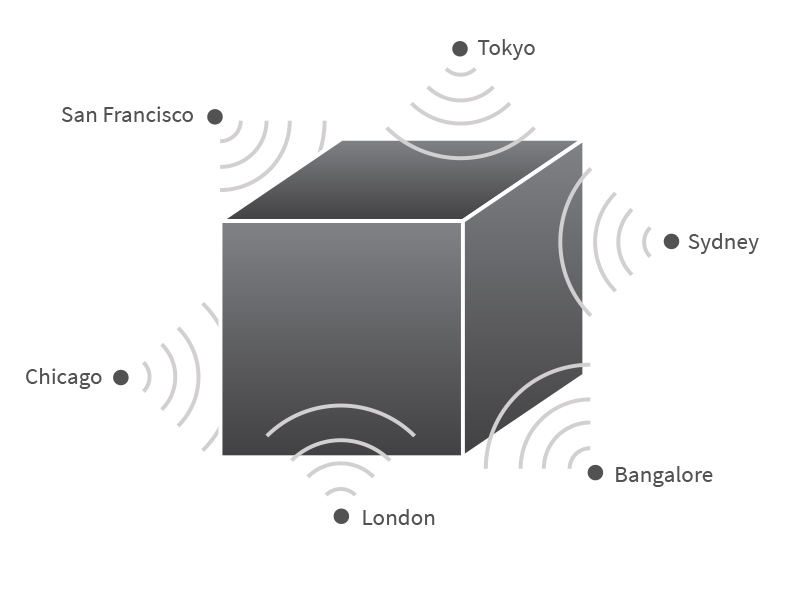
An Optimized Internet Core is ideal for your SD-WAN when better-than-internet performance (but not SLA-backed MPLS-level performance) is required.
Optimized Internet is as it sounds. At its core, it uses the same public IP backbone as the basic Internet. Similar to CDNs, various WAN optimization techniques are used to improve performance. Because the underlying network is not visible or controllable at the node and link level, the performance of these solutions cannot approach true MPLS performance, despite claims to the contrary. Ever.
For the very same reasons, MPLS SLAs are not possible (SLAs covering not only uptime but also packet loss, latency, and jitter, etc.). Public IP simply cannot be guaranteed, or certainly shouldn't be.
Optimized Internet Core solutions use a public Internet core for transport, so they share similar security and compliance profiles — meaning they aren't best practice for companies seeking ultimate enterprise-class end-to-end security or tasked with satisfying compliance hurdles.
In addition, many Optimized Internet Core providers require decryption of corporate data to achieve their performance gains, necessitating a level of vendor trust that is incompatible with a Zero Trust security goal, and further complicating compliance.
In general, Optimized Internet Core solutions are slightly more expensive than basic Internet, but not nearly as costly as traditional private networks like MPLS.
Finally, some Optimized Internet Cores are designed to work with any SD-WAN, while others require you to use the provider's SD-WAN. Read the fine print.
Private Core

When MPLS-level, ultimate performance — guaranteed by a true MPLS SLA — is necessary, you need a Private Core for your SD-WAN. Applications requiring high-performance over long distances, like voice and video, typically fall squarely into this category.
All Private Core vendors see and control every node and link in their network, enabling a predictable level of performance not possible from basic Internet or any CDN-like optimization of the Internet.
What differentiates Private Core vendors are their approach to performance, and the downstream impact to cost, security/compliance, and network flexibility.
MPLS is the granddaddy of Private Cores. It's expensive. It's not an "as a service" offering, so it takes a while to set up and its pricing and usage are fairly rigid. Historically, most enterprises assumed a private network with a low attack surface was enough for security, so data was sent unencrypted. Meaning you have to trust the operator and their virtualization, which most CIOs know to be far from perfect. MPLS does not have a built-in encryption capability, so work must be done to use it in a compliance-sensitive environment with Zero Trust security aspirations. MPLS can be used with any SD-WAN, which is a good thing if you can afford it.
Another Private Core variant can be labeled "cloud MPLS." It takes a carrier MPLS core and makes it POP-accessible, dramatically increasing the flexibility of this solution vs. traditional MPLS. But this approach makes the cost of these solutions essentially the same as MPLS. Furthermore, the only vendor offering this type of Private Core requires data decryption and key sharing with the enterprise — big no-no's in a Zero Trust environment with rigorous compliance requirements. This same vendor requires you to use their SD-WAN with their Private Core, so flexibility is limited.
Mode Core
Mode Core is a Private Core based on a high-performance private underlay from Ericsson and nearly 100 major operators with superglobal POP coverage. Mode has complete visibility into, and control over, this underlay. Mode exclusively uses our version of software-based core control — Perfect Network ControlTM — to drive the global network to perfection every 150ms.
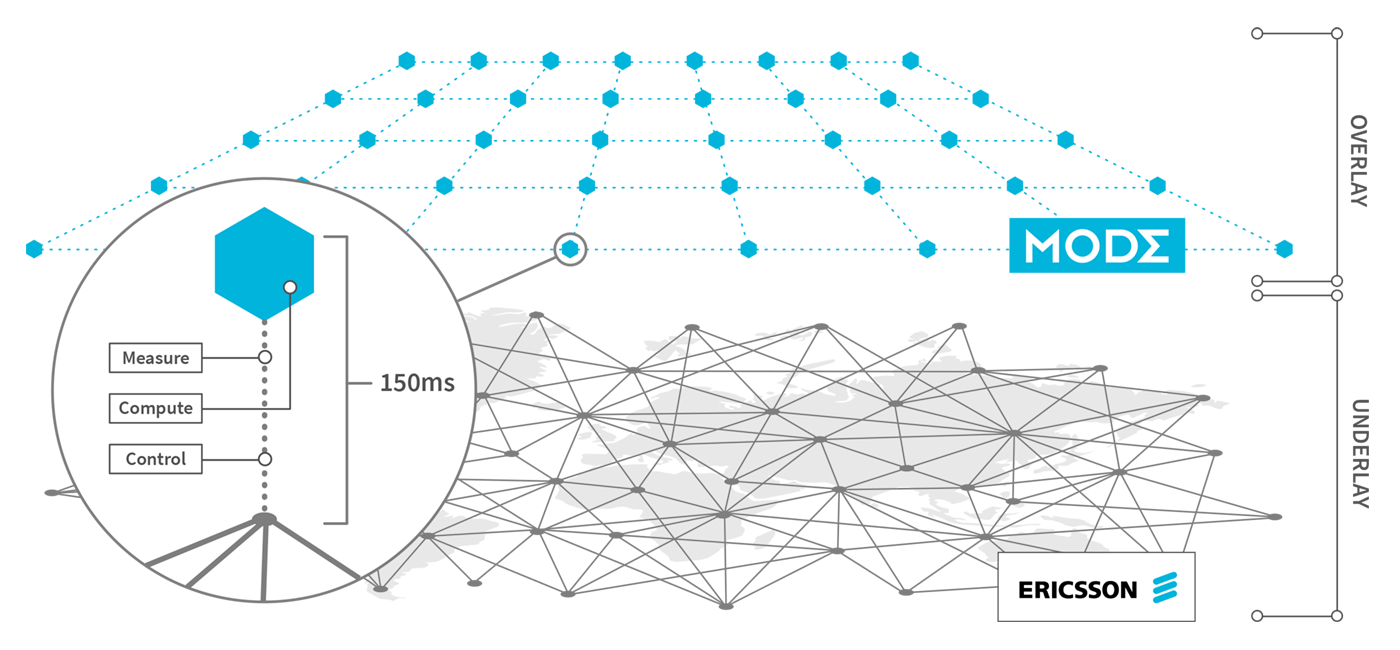
Perfect Network ControlTM is based on the Mode HALO algorithm developed at Cornell and has been proven in tests by the NSF and AT&T to dramatically outperform other core control methods. In the AT&T test, Mode optimized a massive network in 30 seconds, while the second-place core control algorithm took nearly 24 hours. I'm not allowed to tell you who that was, because that would be embarrassing. Perfect Network ControlTM makes for a vastly more efficient Private Core and allows Mode Core to deliver real-world MPLS performance at a price point competitive with business Internet or Optimized Internet Cores.
Mode Core is a Zero Trust Network. It features full end-to-end encryption. Security keys and policies are under the exclusive domain of the enterprise and never shared with Mode. We achieve our SLA-backed MPLS-level performance (MPLS-level uptime, dropped packets, latency, and jitter, worldwide) without compromising security. This makes it easier to satisfy strict compliance requirements.
Finally, Mode Core works with ANY SD-WAN. Your SD-WAN — now with an affordable, high-performance private global network in under 60 seconds.
Mode Core is the ideal SD-WAN connectivity option when flexible, SLA-backed MPLS performance and ultimate enterprise security and compliance matter the most — all while keeping costs far lower than other Private Core options.
Mode Core is the No-Worry Network for Any SD-WAN.
Which begs the question: what is Perfect Network ControlTM and how does it achieve this amazing mix of affordable performance and security?
That, my friends, is for another blog, and another day. See you soon!
Another holiday, another cultural controversy. Are we having fun yet?
Still, as tempting as it might be to wade into these particularly murky musical waters, we should probably focus on something we can ALL agree on...
... the euphonious hum of an always-on business, powered by a hybrid cloud-enhancing network that energizes your SD-WAN and never lets you down.
But now, our first great news of (almost) 2019: Business Insider has named Mode as one of 44 enterprise startups to bet your career on in 2019! That's a pretty strong endorsement. Question: will this be enough to stop my dad from asking me to stop playing in technology and return to medicine? Answer: probably not. That said, we are really thankful for the recognition. Without a doubt it's going to help keep our business always-on. We will gladly pay this benefit forward to our SMB and enterprise customers who have been living on borrowed time by trusting the Internet Core for mission-critical connectivity. And if you're super-talented and in the SF Bay Area, check out our careers page.
Now, back to (always-on) business:
Are All Internet Core Alternatives Pretty Much the Same?
-or-
How does Optimized Internet compare with a Software-Defined Private Core (SD-CORE)?
In our last installment, network control was front and center in our discussion of how to enhance SD-WAN. It was our intention to segue into the vital topic of security, and we will. But we'll do it next time.
Our last blog generated a ton of requests to enumerate the differences between two common approaches to Internet Core alternatives for SD-WAN: Optimized Internet vs. Software-defined Private Networks.
To recap: if you're using the best-efforts Internet to connect your SD-WAN CPE, you're leaving your network open to the outages, performance irregularities, and security risks of public IP. If it hasn't caught up with you yet, it will. Instead of popping Maalox waiting for the other shoe to drop, we humbly suggest getting instant peace of mind by pairing your SD-WAN with a more reliable backbone. But how do you choose?
"An Optimized Internet core and a Software-defined Private Network core (like Mode Core) are not the same thing, and the differences can have a significant impact on your ability to run an always-on business with your SD-WAN."
First, a point of clarification. Many Optimized Internet providers position their network as "their" network, and imply it's "software-controlled." Not trying to be mean — but this is highly misleading. Their POPs are, indeed, theirs, but everything in between them — the vast majority of infrastructure and distance across which your critical business data will travel — is nothing more than best-practices internet, decidedly not "theirs." As for software control: yes, they control their POPs, but they have no direct visibility or discrete control of the massive, global internet hairball stuffed between those POPs.
With that out of the way, let's consider the four meaningful differentiators of Optimized Internet vs. a true SD-CORE for SD-WAN: measurement, control, security, and service-level guarantees.
Knowledge Is Power
Perfect control comes from realtime, global knowledge of granular network performance. Every node. Every segment. Every 150ms.
Optimized internet approaches use a series of POPs distributed around the world to probe the behavior of the Internet. In between these POPs is a massive collection of various providers' nodes and segments, all of which are completely invisible to this class of provider. To the Optimized Internet provider, the core network is a black box. They can measure the performance among their POPs, a time-consuming attempt to guess what's going on inside. It's less granular knowing and more ballpark guessing. And their rate of observation is often far lower than the actual rate of global network change, so you're left chasing your own tail.
An ideal software-defined private network like Mode Core sees each node and every segment of the underlying global network — in real time, every 150 ms. That's because the underlay network is made available to us, and guaranteed by partners like Ericsson and nearly 100 service providers around the globe. In fact, Mode Core grows more capable and comprehensive with each new operator underlay added to its pure, software-control fabric. The ability to continuously know real-time network performance — at a granular level, globally — enables Mode Core to react instantly to rapid network changes. Perfect Network ControlTM begins with perfect knowledge of the network.

You Can't Beat Perfect
Once Optimized Internet providers identify an "optimal path" from their POP approximation of "black box" Internet performance, they move traffic onto that path. After some time, when a new "optimal path" is identified, traffic is switched from the old path to the new. Typically, this "path switching" is far slower than actual dynamic network changes, often with significant time (hours) between switches.
In the language of control systems, this is known as "bang-bang" control, and in the world of packet networks, it is chock full of performance problems. If one were to examine bang-bang control between two possible paths, you'd see a saw-tooth pattern of segment throughput for each path, with 180 degrees of shift. The end result is a severe underutilization of the underlying capacity of both paths over time. The story with latency is just as bad. Bang-bang control systems experience wild latency swings (and jitter), and an average latency that's far from the ideal physical limit. Combine this with the inherent (and uncontrollable) latency and performance variation of the Internet Core, and you have real problems.
A few years ago, a group of researchers at Cornell did something previously considered impossible by computer scientists: define packet networks as control systems. Their math-based control solution, Mode HALO, went on to wow the academic world and dominate NSF and AT&T software-defined networking competitive evaluations. It also served as the foundation for Mode, and Perfect Network ControlTM.
We know what you're thinking. Perfect is pretty cocky. But in this case, it's not marketing exaggeration, it's truth. As we monitor real-time changes for every nook and cranny on our global private network as a service, every node in our network computes the perfect control solution for every packet, based on math — instantly, and in parallel. This allows Mode Core to drive the network towards utilization, throughout, and latency perfection in the face of dynamic changes that would crush any other network. And it allows Mode, and Mode alone, to offer a unique mix of carrier-grade performance and affordability.
So while Optimized Internet providers may have fancy names for their magical measurement and control techniques (some of them use Artificial Intelligence!) nothing beats perfect, math-based autonomy for keeping your network always-on.
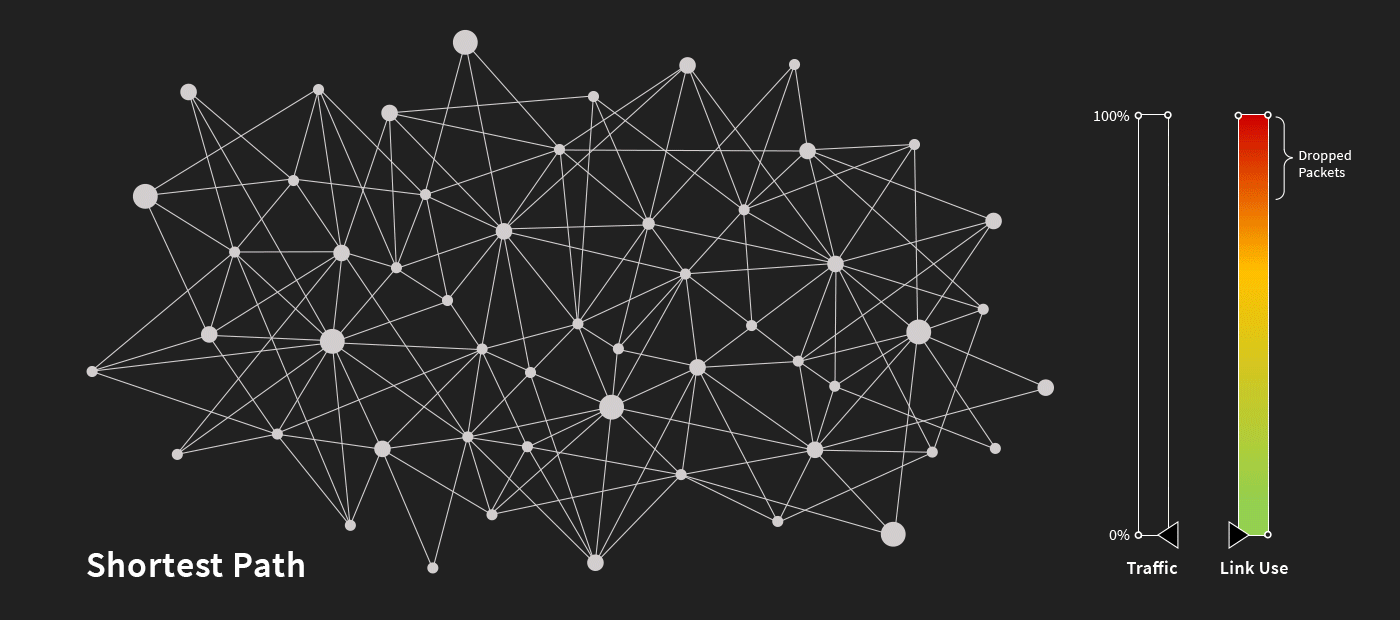
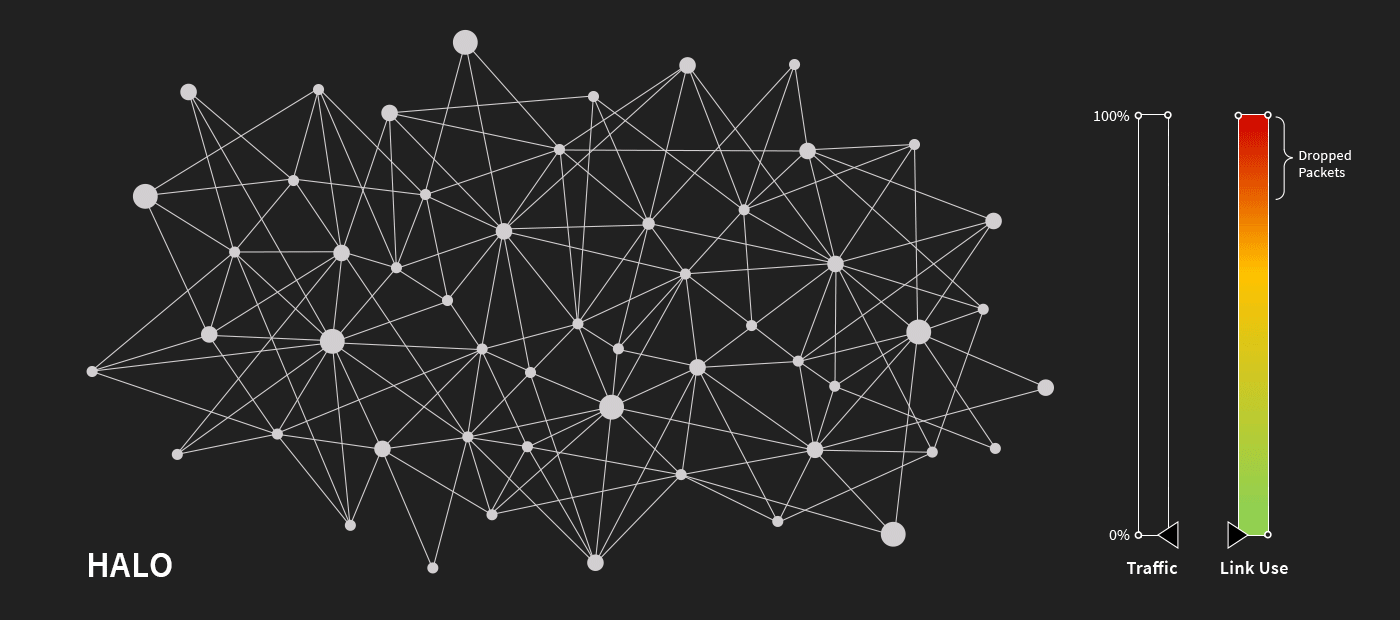
Trust Nobody
There is a best-practices approach to business security called Zero Trust Architecture. You can read more about it here. The basic premise is an IT design where your business security is not predicated trusting ANY third-party vendor used in the design. That's revolutionary.
So why would you spend the time to create a Zero Trust business architecture, and then connect those business branches and multi-clouds with a network that REQUIRES you to trust the network provider, or worse, the Internet?
Many Optimized Internet providers require you to decrypt your network traffic in order to achieve their performance or functional benefits. You have to trust them with your security keys and security policy. Not good.
In addition, since the majority of their transport infrastructure is Internet (e.g. not under their supervision, control, or liability), it is subject to redirection errors or flat-out BGP hijacking — both of which are happening ALL the time. (See China's Maxim – Leave No Access Point Unexploited: The Hidden Story of China Telecom's BGP Hijacking and Google goes down after major BGP mishap routes traffic through China). All of this impacts performance, but are also major security vulnerabilities. Sure, your data is encrypted. But when this same, sensitive data is hijacked to a malevolent state entity with virtually unlimited resources, are you willing to bet your business on it?
That's the idea with a Zero Trust NetworkTM — your data is safe precisely because you don't have to trust the provider, or anyone else. Mode Core is a Zero Trust NetworkTM. We achieve our tremendous performance levels without decrypting your data. All security keys and security policies remain under the exclusive control of your business. And we are a private network, with the lowest of attack surfaces (especially vs. Public IP) — meaning we are hijack-immune. If you've implemented or are considering a Zero Trust architecture for your business, it only makes sense to pair it with a network that preserves your security investments.

Rubber, Meet the Road
All of these factors contribute to the most-important of bottoms lines — the kind of guarantees your network provider offers.
The gold-standard from traditional enterprise networks like MPLS is a carrier-grade SLA. It covers uptime, and discrete performance metrics like packet loss, jitter, and latency variation. They can offer these guarantees because the network is theirs, and under their control.
Not so with Optimized Internet providers. They can offer "uptime guarantees" that cover the uptime of their POPs. They can't guarantee the uptime of the Internet, after all. Nor can they control (or guarantee) its performance.
Mode Core, like MPLS, offers a carrier-grade SLA. Uptime, jitter, latency variation, and packet loss, worldwide. The essential elements of giving you an always-on business that hums. But unlike MPLS, with Mode Core you can spin up a global network that supports hybrid and multi-cloud businesses with remote workforces in under 60 seconds. Really.

It's a New Year. 2019. And in this year of explosive SD-WAN growth, there is nothing better you can do for your business network than to pair your SD-WAN with the right SD-CORE, Mode Core. Getting and maintaining a reliable WAN was never this easy or affordable.
This month we are very pleased to host a webinar featuring the Managing Director, IT of one of the world's largest law firms. He worries about keeping his business secure and always-on, all the time. If that sounds like you, you owe it to yourself to listen in. Dates and info coming in our next blog.
...but the right SD-CORE will make you believe it could be.
It's that time of year. 2018 is on its way out the door. We're winding things down, and we're making plans. And in 2019, the single most important thing you can do to enhance your SD-WAN is to connect it to an SD-CORE.
That's the way you keep your business always-on. In fact, it's the best present you can give to your CIO or VP Net Ops this holiday season: peace of mind. Nothing beats a reliable WAN that is easy to start and maintain, and that won't drive you to insolvency.
But which SD-CORE do you choose? Rather than give you a huge list of 10 or more categories, I thought we'd stay true to our roots, and simplify. When it's all said and done, every meaningful distinction among SD-COREs comes down to differences in control and security.
Control Matters
There are a million different companies with an equal number of claims of magical routing or WAN optimization techniques. The names and claims are really impressive, but give you no real information. And that's a shame, because HOW the SD-CORE is controlled matters a LOT.
Here's the reason — the better the control, the more efficient the SD-CORE. And the more efficient the SD-CORE, the lower the cost for a given level of performance.
That's a pretty convenient litmus test. Forget the fancy names. Look at the SLA. If there isn't an SLA, move on. And if there is one, look at the numbers. They're usually pretty similar among vendors. And then look at the price. Higher pricing means less capable control.
There are a few other signs if you're looking closely. By far, the best level of control is at the individual packet level. If a vendor doesn't own the backbone network or have a direct relationship with the backbone provider, they can't control each and every packet. So you can toss out SD-COREs that rely on public IP backbones because they can't see packets end-to-end, never mind control them every step of the way.
But let's say the SD-CORE provider offers packet-level control of their own backbone. Let's say you're Google or something like that. You're using advanced AI techniques to analyze the network, then compute a centralized solution, and then push that solution across your network. That's pretty good, except for the fact that it takes time to do this analysis and push it out, and in that time everything has probably changed. After all, AI is figuring out the best solution in the face of insufficient information. Turns out, when it comes to packet-switched networks, you have all the information you need for an autonomous solution. And autonomy is not only better, it's best.
Autonomy trumps AI because, ironically, it doesn't require any intelligence. Every node on the network can independently calculate its own perfect control solution, in parallel. Whether the network has 10, 10 thousand, or 10 million nodes — the speed of the control is only limited by the time it takes to measure the network. And that, for a ball the size of the earth, is only 150 milliseconds. Tops.
That's Perfect Network ControlTM, and only Mode has it. We start with world-class private underlays from providers like Ericsson and other major service providers. They've kindly allowed us total control of every packet on the network, end-to-end. We seamlessly stitch them together for superglobal coverage, and the result is an SD-CORE unlike any other: Mode Core. And while we can never claim Mode Core is perfect, the solution that every node on our network uses is nothing less. Perfect Network ControlTM continuously drives Mode Core towards a perfect network — in the face of ANY external changes — every 150ms.
The result is unmatched efficiency, typically 300% better the state-of-the-art. It's that efficiency that lets Mode Core deliver worldwide high-availability SD-CORE performance for a price no one else can touch.
Want to know more? Come listen to Mode CEO Paul Dawes on December 20 as he discusses Enterprise WAN in the Cloud Era.
And come back to this blog next week when we'll tell you about the second most-important consideration in choosing the right SD-CORE to enhance your SD-WAN: security.
You've got to hand it to Amazon. They have their fingers in a LOT of pies. Makes you think – if they had known they'd get this pervasive at the beginning, maybe they'd have chosen a different name. I mean, the jungle is pretty big, but it's not a global phenomenon.
Global Accelerator from Amazon is, as its name implies, truly global. No, it's not a startup incubator (sure sounds like one, ahem). It's Amazon's SD-CORE for AWS. It's hot off the presses for those of you attending AWS re:Invent in Las Vegas. It takes its place side-by-side with Azure Virtual WAN and Edge Gravity by Ericsson as the latest SD-CORE from a major cloud provider. And, if you think about it, it validates four major realities facing cloud-era businesses, many of whom have adopted SD-WAN.
1. Internet Core just doesn't cut it.

OK, Amazon does the same thing we do when we talk about the Internet – treat it with care. Because, really, we love the public Internet. It does amazingly well as a best-efforts system. But here's the rub: Amazon would not have built Global Accelerator if AWS customers weren't having performance and availability issues using the Internet Core. According to Peter DeSantis, AWS VP Global Infrastructure, Amazon wants to improve the performance and availability of applications running across AWS regions by bypassing the public Internet and transporting data on the AWS Global Network. In particular, he calls out applications like voice, video, interactive experiences, and those requiring long-haul traffic. Sounds pretty ubiquitous.
2. Internet Access is part of the solution.

Like any SD-CORE, AWS Global Accelerator relies on last-mile Internet Access. We've cited many studies that have shown that Internet Access is very capable of being a part of a reliable software-defined WAN solution (SD-CORE QoS Without MPLS from SD-WAN Experts, and Addressing SD-Core: Boosting SD-WAN performance without MPLS from Cisco), and Amazon clearly agrees with this assessment.
3. The world needs a Multi-Cloud and Hybrid-Cloud SD-CORE.
As cool as this is for AWS customers, there is a lot more to keeping a business always-on than just AWS. Businesses need an affordable, reliable, SD-WAN compatible solution that covers the broadest set of enterprise use cases: branch and data center connectivity, all IaaS and PaaS clouds, and the gamut of SaaS applications. An unreliable, unpredictable, and often unsecure Internet Core (see Google goes down after major BGP mishap routes traffic through China, Suspicious event hijacks Amazon traffic for 2 hours, steals cryptocurrency, and Strange snafu misroutes domestic US Internet traffic through China Telecom from ArsTechnica) makes always-on unobtainable at worst, or difficult at best for IT and NetOps. Given that Global Accelerator may very well diminish traffic on Service Provider backbones, this is a major opportunity for SPs to step up and offer an SD-CORE that doesn't just serve Amazon's needs. Hint.
4. Affordability: the big omission

Truth is, there is an Internet Core alternative out there already – MPLS. It's the traditional approach, but it's got two major knocks against it: it's expensive, and it's decidedly inflexible, in a few significant ways. These downsides have been the major impetus for SD-CORE alternatives, so it would be ironic if these same alternatives priced themselves out of widespread adoption. Here's the rub: it costs a lot to run a highly available private IP backbone using today's industry standards. Even if you're Amazon, unless you change the fundamentals of network control, a private HA solution is going to cost. The CSP model is also a problem for always-on businesses. It's predicated on making it very inexpensive to get data in, but very expensive to get that same data out. That makes sense when your strategy is to keep customers on your cloud, but it's antithetical to the needs of cloud-era businesses who really need multi-cloud, affordable, HA, secure bi-directional data transport in ever-increasing amounts. That's why we are so excited about Perfect Network ControlTM. When you re:Invent network control, and you triple effective network utilization, you deliver an otherwise unobtainable mix of flexibility, reliability, AND affordability.
An SD-CORE that costs the same as business Internet, but with QoS and SLA guarantees, that supports multi-cloud, hybrid-cloud, every SD-WAN, and pretty much every other enterprise WAN use case? Now THAT'S re:Invention. And that, my friends, is Mode Core: table stakes for keeping your business always-on.
We're not the only ones who think so. Searl Tate, Managing Director, Information Technology of Paul Hastings LLP, has this to say about keeping his global law firm always-on: "Mode stands out as a unique option that offers all facets of reliability, security, flexibility, and value in a software-defined private enterprise WAN — today. Mode understands the importance of an affordable high-availability 'middle mile' and Mode Core delivers."
Speaking of always-on: enterprise security plays a big role in giving IT and NetOps peace of mind. It's a hot topic, as is Zero Trust architecture. So what's the role of SD-CORE in all this? re:Inventing end-to-end security in the cloud era, of course. Come back next time to find out how.
Read more about AWS Global Accelerator SD-CORE here.
One of the benefits of being in a startup is that you have a lot more freedom to completely go off the reservation, on occasion. Once you get to a certain size, everyone gets a lot more serious. And then this kind of editorialized fun comes to a dead stop. You know what I mean. So let's enjoy it while we can, shall we?
Welcome to the millennial edition of the Mode blog, and the third part in our analysis of Steve Garson's (CEO and Founder, SD-WAN Experts) ONUG presentation "Measuring Internet Core Variability" aka "Is the Internet Core a Safe Space for Packets" aka "Is Your SD-WAN Relying on a Turkey of a WAN."
But first... Let's talk about perfect. At Mode, we are lucky to have something at our disposal called Perfect Network ControlTM. What is it, you ask? Well, it's pretty rare in technology to have something that's truly perfect. And that's why this is so very cool. We will cover this more in a future blog, but Perfect Network ControlTM isn't an exaggeration at all. It's how Mode controls networks and continuously drives them to perfect efficiency, every 150ms. And we all know, nothing beats perfect.
The point is, most things aren't perfect. For example, the platform we use to host our webinars (it's ok, we know perfect is hard). Turns out, it wasn't cooperating at the scheduled 10 AM November 14 time and date. So — for those of you who couldn't make Steve Garson's presentation on "Three Must-Do's to Get Peak SD-WAN Performance" — this is your chance to not get left behind, and learn about three common-sense steps to get more from your SD-WAN. Even better, you get to eat turkey first.

Featuring: Nithin Michael, Founder & CTO, Mode;
and Steve Garson, Founder, SD-WAN Experts
When: Wednesday, November 28th, 10:00 a.m. (PDT)
Register Now
OK. Back to A Safe Space for Packets. I hate to break it to you, but it's time to hand out the blankets, coloring pads, and crayons, because we've already learned that the Internet Core isn't safe at all. Scary.
In fact, its unpredictability is orthogonal to keeping businesses always-on. We'll get into the concept of "always-on" in a future blog, but for now, think technology always doing what you need it to do, when you need it done, to get work accomplished. The network, the technology, just recedes into the background and you totally take it for granted. That's the dream. And all too often, the Internet Core turns it into a support nightmare.
In the third part of Steve's ONUG presentation, he considered a very interesting question — can optimized paths or backbones make a difference vs. Internet Core for long-haul traffic. For example, AWS to AWS optimized paths.
He turned to our friends at Catchpoint to measure AWS-to-AWS performance among the same origins and endpoints of his previous two tests. And the results were quite illuminating.
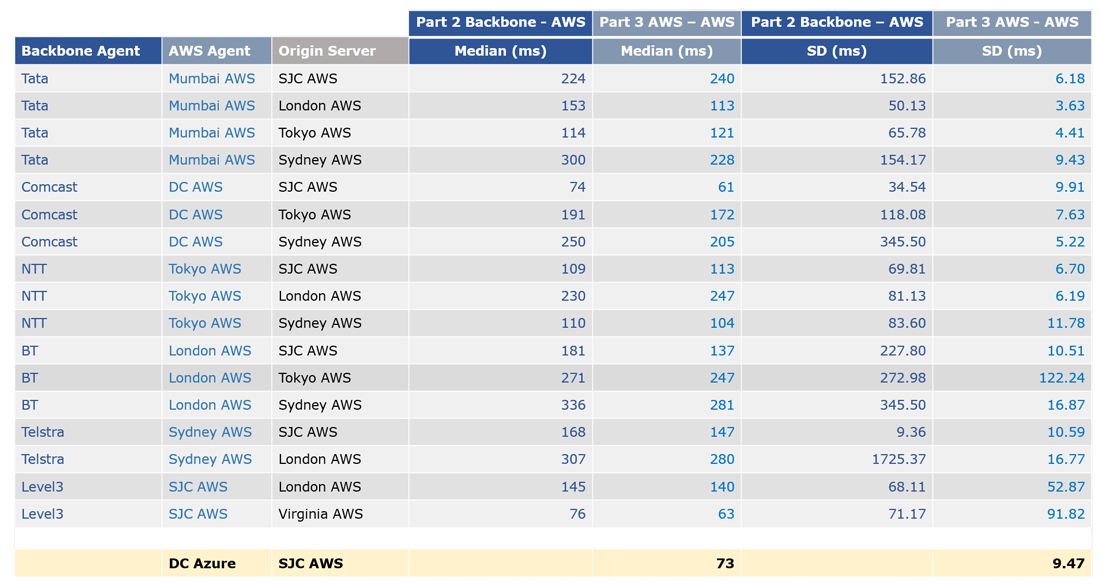
As you can see, in most cases, having an optimized path between points not only reduced point-to-point latency, but also latency variance and jitter. The takeaway point — if your business a) needs to be always-on, and b) relies on long-haul data transport, you can benefit dramatically from an "optimized path."
Steve's conclusions are similar:
So, you want to be always-on. You need to be always-on. And all you want for Christmas this year is flexible, reliable, affordable WAN. Do you pick MPLS? Do you choose SD-CORE with SD-WAN? And are all SD-CORE's the same? Is all network control — with all those fancy names for different kinds of routing or optimization — really the same?
No doubt, these are all great questions. And we look forward to discussing them more in the future.
In the meantime, our friends at Cisco had a LOT of news this week. And mixed in among that news were some very interesting comments on SD-CORE and SD-WAN. Want to know more? Come back next week and find out!
As I sit here sipping my fourth Coke Zero of the day (true), next to a former starting outside linebacker for the 49ers (also true, and a much longer story), I am reflecting on how to break some very exciting news to you.
That's it! I've settled on the direct approach:
Steve Garson, of SD-WAN Experts, has agreed to be our featured guest for the next Mode Webinar. No take backs!
And the topic ... it's Gold, Jerry! P-u-r-e Gold!
Could it have to do with your SD-WAN? Well, yeah. Does it talk about MPLS costs and inflexibility? Maybe. End-to-end encryption, and enterprise control of security policy? Very possibly. Extending edge control to the network core? Definitely.

Featuring: Nithin Michael, Founder & CTO, Mode;
and Steve Garson, Founder, SD-WAN Experts
When: Wednesday, November 28th, 10:00 a.m. (PDT)
Register Now
Now that that's out of the way, we can resume our walkthrough of Mr. Garson's excellent keynote presentation at the ONUG Fall event in NYC. If you recall, his talk offered three experiments relating to Internet Core performance. Last week we covered the first, in which Internet Core response time was extrapolated from measurements of long-haul response vs. last-mile response.
In the second stage of the presentation, he used Catchpoint to directly measure Internet Core response time among the same collection of endpoints, comparing them to the first data set.

The goal was to validate the original data by using two distinct measurement methodologies, and hopefully get similar results.
And it worked! Let's look at the following raw data table:
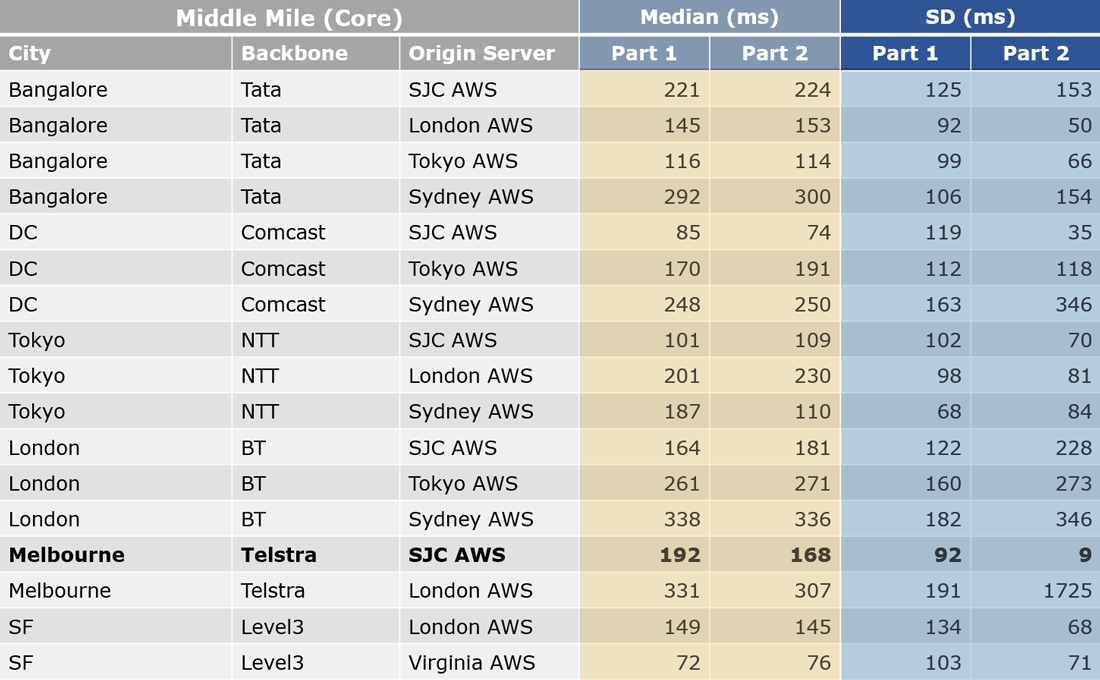
It's pretty clear that the measurements from Part I (last week) and Part II (this week, direct Internet Core measurement) are practically identical (within the margin of error). Both the median and the standard deviation.
With one exception — the route between Melbourne and San Jose AWS. It's likely that Telstra (the backbone provider) is doing something special in moving data back and forth with San Jose AWS. This would account for this path's resistance to latency variance (when compared to generic Cedexis data obtained across a collection of providers, as used in Part I tests).
This leaves us with two takeaways:
Next week, come back to Mode.net for analysis of Part III of Steve Garson's research project and presentation. But for now Save the Date, November 14, 2018, as we host Mr. Garson for a not-to-be-missed Webinar, live from Silicon Valley and the Mile High City. So exert some control — over your schedule — and pencil us in. Your SD-WAN can't afford to miss it.
The cloud era has been anything but simple for businesses. In fact, a lot of the challenges they face may be attributed to how hard it is for network operations teams to consistently provide reliable connectivity among their employees, assets, applications, and services.
So the opportunity is to simplify end-to-end reliable WAN for businesses, large and small. That's why we were at ONUG in NYC (ok, were there for the bagels also). We saw an amazing presentation by Steve Garson of SD-WAN Experts, titled "Measuring Internet Core Variability."
Why amazing?
We've been blogging about the Internet, how it's generally great, but perhaps problematic when it's used as part of an SD-WAN solution for mission-critical business applications.
We've told you about the "good parts" version of the Internet — separating Access from Core. And we've implicated the Core as the primary cause of unpredictability.
We are always amazed when others produce corroborative evidence. At ONUG, others = Steve Garson of SD-WAN Experts.
Let's take a look at the first part of Steve's presentation.
SD-WAN Experts used three third-party tools: Cedexis for long-haul measurement. Catchpoint and Speedtest for last-mile or Access measurement.

Steve chose response time (i.e. send + wait) as the ideal methodology, because it excludes one-time events like DNS and connect, and it's a better measure of real Internet response than ping.
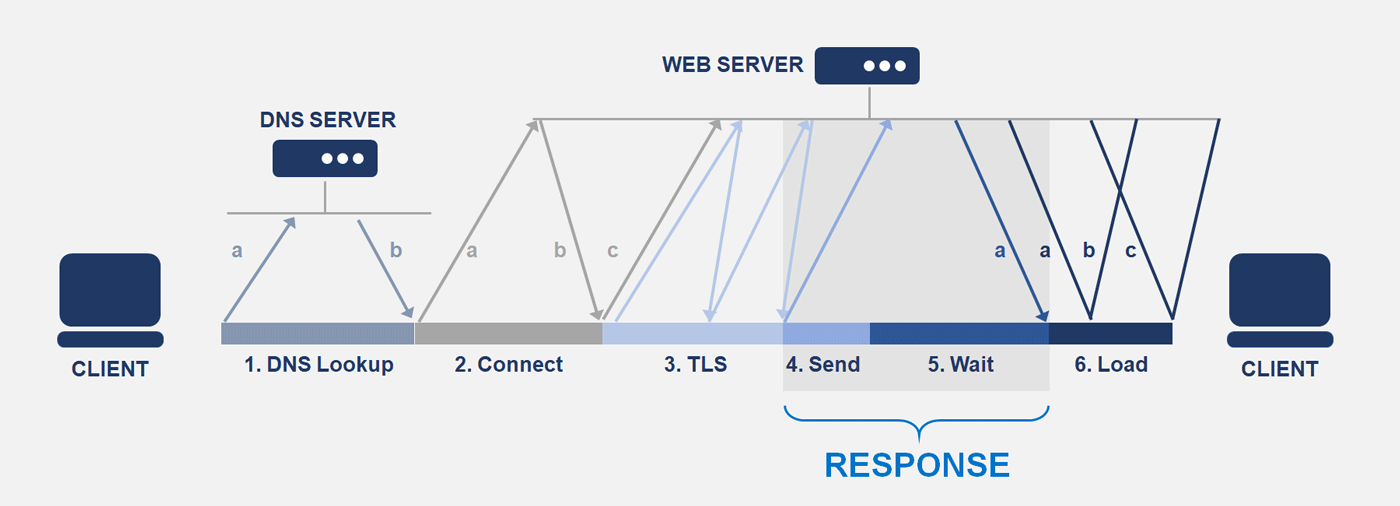
In his first series of tests, Steve calculated Core performance by subtracting access performance from a long-haul performance. Of course, performance varies over time. I'm no mathematician, but I seem to remember that in cases of two parts of a series with variability, the variance of the whole (variance = standard deviation, squared) is equal to the sum of the variance of each part, plus two times the covariance (the correlation of variance in part one with part two).

I think it's a safe assumption that, in general, performance variance of the last-mile is wholly independent of core variance, meaning covariance = 0. Steve makes this assumption, which means the long-haul variance = core variance + access variance. Whew. We are done with the math.
Steve collected data from servers originating in San Jose, London, Tokyo, Sydney, and Virginia. He looked at the performance to end users in Bangalore, Washington D.C., Tokyo, London, Melbourne, and San Francisco. Here is a table of the raw data:

The results are pretty clear. For long hauls, the vast majority of response variance occurred in the Internet Core, not the last-mile. In fact, 99.5% of response variance happened in the Internet Core. That means that your business traffic, over long hauls, is experiencing the vast majority of dropped packets, jitter, etc., as a result of the Internet Core. Even with the lovely software-defined benefits of SD-WAN at your corporate edge.
99.5% of long haul Variance happens in the Internet Core. Why?
It's largely an issue of economics. Internet Access networks receive 300% to 1000% the investment of the Internet Core, most of it coming from customers. The Core is based on least-cost peering and routing.

Steve went on to provide additional tests of Internet Core performance, and we will cover them in upcoming blogs.
But for now, we know one thing for sure. If you want to simplify reliable end-to-end WAN so your businesses can hum, you can't stop at SD-WAN. You need to replace the Internet Core with something far more reliable. You could use something overpriced and rigid like MPLS. But you really want something that's SD-WAN friendly, flexible, and affordable. You may not know it yet, but your want a software-defined core (SD-CORE).
Jennifer English at TechTarget has done a nice job reviewing Steve's presentation. Her conclusion — you may not be able to rely on SD-WAN + Internet, but you no longer have to pay for expensive solutions like MPLS. SD-CORE might be just the thing for simplifying the reliability of your SD-WAN.
Who doesn't love The Princess Bride? I got my first copy at the Dartmouth bookstore outside of summer camp (for those who've been reading this blog, you'll recognize the tie-in to the very first Mode post). No, the movie isn't nearly as good.
It was a tight book. A real page-turner. In fact, this masterpiece by William Goldman was an abridged version of the hideously plotted, unedited, and unreadable original version, penned by S. Morgenstern. Or so Goldman claimed. In fact, it was a clever, but bogus, literary device. Now I digress.
So what do R.O.U.S. and "as you wish" have to do with this next part in our blog series of "Is the Internet good enough for mission-critical business?" Quite a bit, actually. Or at least one bit.
In our last blog, we showed evidence that the Internet was too unpredictable to support mission-critical business applications (or other applications like streaming gaming, and a whole host of next-generation devices, applications, protocols, and services — from IoT to blockchain to 5G).
We must ask: do we dismiss the entire Internet on this basis? Or is there a "good parts version" of the Internet that we can carefully separate, and use with confidence as part of an end-to-end cloud connectivity solution? (I know you were waiting for that tie-in, and yes, you're welcome).
It's common practice to divide the Internet into two parts — the on and off ramps we call Access. The center, we call Core. Access has different names like last mile (or first mile), and Core is sometimes called backbone or middle mile. So can we attribute the unpredictability of end-to-end Internet entirely to either Access or Core? Is it really that easy?
It turns out that we can, for the most part. Internet Access outages are exceedingly rare. Physical network distances at the last-mile are relatively short, and global, long-distance studies show that Access contributions to latency and jitter are relatively insignificant vs. end-to-end values. Solutions like SD-WAN offer additional Access resiliency via redundancy. Additional studies of last-mile U.S. operators reinforce this truth: Internet Access is predictable, can be trusted, and is getting better all the time.
This makes sense when you consider how well-capitalized and well-marketed Access solutions are. It's a highly competitive marketplace, and poor performance is a deal-breaker.
The Internet Core is an entirely different story. It's not nearly as visible, not heavily marketing, and is composed of complex peering arrangements that shift continually. Its "shortest path" priorities are often economy, not performance. Third-party tests show that the vast majority of latency variation (jitter) happens in the Internet Core, as do daily globally-dispersed Core outages that have not gotten better over time.
This leaves us with a remarkable conclusion, one our SD-WAN partners have known for some time: the "good parts version" of the Internet is Internet Access. It is the Internet Core than requires a more predictable, higher-performance alternative.
SD-WAN has led the way by bringing software-based control the edge of the enterprise WAN. What if we adopted this approach, and brought software control to the Core? That would be remarkable. But how?
This isn't a Princess Bride-style "battle of wits." We know the answer, and we'll happily tell you in our next blog installment.
We aren't alone in our search for an Internet Core alternative that's SD-WAN-centric. Steve Garson @ SD-WAN Experts just published an article detailing various ways to take the goodness of SD-WAN and extend it end-to-end across the WAN core. You can read Steve's article here.
Yours truly,
Mode
There was no Bogart. No tearful goodbyes. But the Mode team left Paris with something better — confidence. Not just our confidence, but yours. You, the CIO, the VP Network Operations. For some time, you've feared the transition to the cloud.
You've woken up at night in a sweat. And that fear has made you cling to the past. To rigid, expensive, and decidedly cloud-unfriendly connectivity solutions like MPLS.
We left Paris, and we gave you the confidence to let go. The confidence that the cloud could deliver both where MPLS succeeds (reliability and QoS), and where it falls short (flexibility and economy).
We didn't start the ball rolling. That was SD-WAN. It gave you confidence in the edge of your network, with visibility, and the flexibility to chose among different networks. It made site-to-site connectivity a snap. And it did it without breaking the bank.
Still, you knew that at its core, it was still using the Internet. And that made you nervous. And for good reason. The Internet Core is anything but reliable. At least SD-WAN let you pick and choose, and that's exactly what you did, using MPLS like the preciously expensive resource that it is.
And then you came to Paris. You saw Paul Dawes, Mode CEO, at the Summit Keynote. And everything changed when he told you about SD-CORE.
SD-CORE sounds a lot like SD-WAN, and that's not an accident. Where SD-WAN brings software-defined control to the edge of the enterprise WAN, SD-CORE takes it end-to-end, across the world's highest-performing private global network as a service.
The need for an SD-CORE has never been greater, and in Paris we learned we are not alone. We saw SD-CORE like projects from Cisco (NGENA) and VMWare. All driven by the need for a better middle mile and the increasing reliability and performance of Internet access. But only Mode offers a network operating at the theoretical limit of packet-switched efficiency. Translation: an untouchable combination of performance and economy.
Mode has replaced that pesky Internet Core with the world's highest-performing SD-CORE, and it works with any SD-WAN with the turn of a key. Still, it was Paris, and you know what those arrondissements can do to star-crossed technology companies. In fact, rumor has it that Mode and Versa Networks were seen holding hands at the Tuileries (read the press release here).
We also saw lots of traditional vendors piling into the SD-WAN space, each trying to differentiate via a better end-to-end experience at a reasonable price. Enter Mode, and our SD-WAN + SD-CORE partner program.
Paris is now a memory. But now you're more confident in the cloud than ever. You know that the combination of SD-WAN and SD-CORE gives you MPLS-level QoS and reliability AND cloud flexibility, and it does it at a business internet price point.
Bonne nuit et beaux reves!
Talk about a busy week. You know the way fast-growth startups can be. Some weeks, you're just pushing that boulder. And other weeks, it comes at you nonstop, and you just don't have enough hours in the day.
This week is one of those.
First, we are incredibly pleased to welcome Versa Networks to the Mode fold (read the press release). Big handshake. Versa Networks is a leading provider of SD-WAN solutions, and the first to join our newly minted SD-WAN + SD-CORE Partner Program. What's that, you ask?
Well, it's like peanut butter and chocolate. Or Gracie and George (Meghan and Harry for you millennials). Two great things that are just better together. SD-WAN brings cloud service flexibility to the edge of the enterprise WAN. That means easy setup and management, and edge visibility. Still, lots of folks continue to use rigid, expensive legacy connectivity solutions like MPLS because of its rock-solid reliability (hint: that's not good cloud etiquette). But we understand. There was no good alternative. Until now.
Mode has stretched the software-defined goodness of SD-WAN, and brought it to the core of the network. We use our breakthrough autonomous routing control to make our cloud private network as reliable as MPLS, but as affordable as business internet. We call this flexible network-as-a-service SD-CORE, and it's built to literally turnkey enhance any SD-WAN. All that SD-WAN edge goodness of flexibility, reliability, and visibility now goes end-to-end, over the entire corporate WAN — for the cost of business internet. We think that's pretty sweet. Peanut butter and chocolatey goodness.
Versa is our first SD-WAN partner. Together we are making enterprises big and small confident in their transition to the cloud. No more clinging to legacy connectivity solutions. It's ok, you can let go, little by little if that makes you feel better.
In other news, Mode is at the SD-WAN Summit 2018 in Paris! And … we are a Diamond Sponsor!!! Funny, because of the shape of those tetrahedral carbon bonds sort of looks like an autonomously routed network, but that's just me. Our CEO Paul Dawes is giving the keynote all about the need for the SD-CORE I just described. Nithin Michael, Ph.D., and Mode co-Founder will talk about how he brought the world's first autonomous network to life.
When we aren't presenting, you can find us celebrating in the Versa booth, where we will show you how Versa + Mode = SD-WAN + SD-CORE = Better Together = Cloud with Confidence. That's math that I know you'll appreciate. See you there!
In our last blog, we asked a simple question: is the internet good enough? In fact, this is typically how our sales conversations start: Mode Sales Guy, "Hi VP IT, why do you use MPLS today when the internet is so great and cheap?"
This question elicits two different responses:
Response 1:
VP IT: Oh, I don’t use MPLS at all. We don’t really use UC or VoIP, or have any sensitive applications that run in our data center or cloud. Basically we just pump everything over the internet.
Mode Sales Guy: Great. Have a nice day!
Response 2:
VP IT: Look, I hate the cost of MPLS. It’s also a real pain to work with — slow to setup, hard to change, cloud unfriendly. But I don’t have a choice. Any problem — video conference glitches, voice call dropouts, access or performance issues — it’s all my fault. Saving money over reliability isn’t worth it. So we use MPLS for mission-critical, and the internet for everything else.
Mode Sales Guy: What if I told you that you could save money and gain flexibility, without affecting reliability?
It’s pretty common for IT departments to complain heartily about MPLS, but not believe that they can rely on the internet to replace it.
Remember that this question is the first in a series of three:
Let’s assume for a moment that IT is just being conservative, and look for outside, broader answers to the first question beyond just businesses that use MPLS.
If you think about it, the entire CDN market came into being a while ago because the internet wasn’t good enough for delivering video. The persistence of CDN solutions like Amazon and Akamai suggests it still isn’t.
On the gaming side of things, companies like Riot Games spent millions of dollars to build their own backbone because the Internet isn’t good enough for their gamers. Imagine that — a gaming company becoming a network operator. That’s desperate. And they’re not alone. Nvidia built the GeForce NOW edge network because the Internet isn’t good enough for interactive streaming.
Finally, it’s pretty clear that the $40B+ MPLS market is evidence that the Internet isn’t good enough for mission-critical business applications. Here you’d have a ton of IT professionals nodding in unison about the need for global, consistent reliability with an SLA for mission-critical cloud access, unified communications, VoIP, etc.
It’s pretty clear that there are growing number of applications which require more reliability than the Internet can deliver. In this post-HTTP world, that trend is accelerating.
So the next logical questions are: why is this true? And, can we do anything about it?
If you think Mode might have something to do with the solution, let’s just say you’d be getting pretty warm right about now.
How's that for clickbait? OK, in fairness, the internet is pretty darned good. I like to think of it as the biggest infrastructure project in the history of humanity (truth). It's transformed our lives and our world in profound ways. It seems pretty short-sighted to rail against it.
But, it's a living network. It's not static (although most routing techniques are, go figure). So it can get better. And questioning its capabilities is part of this process. Fair?
Beyond the clickbait, the question I'm really asking is this: is the internet good enough for mission-critical applications? You would think it is, because more and more businesses are running hybrid clouds. They're keeping lots of their mission critical data in the cloud. And over 90% of employees rely on the Internet to access these apps and this data. They're putting a lot of faith in the internet. How's that going?
This question opens up a boxful of follow-ons:
And that, ladies and gentlemen, is the subject of our next series of intriguing and informative blog posts.
Stay tuned! (Hint: we know the answers, but the slow reveal ... priceless)
We were very excited to read that Cisco was integrating their Viptela SD-WAN into one million of its routers. Cisco is clearly committed to SD-WAN, everywhere. At Mode, we are committed to ENHANCING SD-WAN, everywhere. We are thrilled that we are so aligned!
SD-WAN does amazing things, of course, which is why Cisco wants it ubiquitous. It simplifies enterprise WAN setup and management, and offers edge flexibility and edge transparency. It's all about visibility and flexibility, actually.
Which is why it's so disheartening to hear that so many businesses are dissatisfied with the performance of their cloud applications. Inconsistent SaaS performance. Dropped connections to IaaS. Laggy VoIP and unified communications. As good as SD-WAN may be, it's only as good as the networks available to it.
And while the ISP last-mile offers the kind of performance that can support mission-critical business applications, the internet's core is inconsistent. A best-efforts internet core means intermittent dropped packets, and lots of latency variance. That translates into poor SaaS, site-to-site, UC, VoIP, and remote access experiences. The alternative to date has been MPLS. Problem solved — but at a cost. A very big cost. Money and time, actually. While SD-WAN helps IT folks keep those costs down by saving only the most-important application traffic for this costly hardware-defined network, enterprise needs something better. Soon.
Enter a new breed of cloud networks, with big promises (we're one of them of course). Some of them offer MPLS-like performance, but at an MPLS cost. Their feature — flexibility. But only with their own SD-WAN. Others still use the internet core network, but offer global POP access and some optimizations. Again, only with their SD-WAN. None offer the performance of MPLS, the flexibility of cloud, and the price of business internet. With ANY SD-WAN.
Except Mode. We are a reliable and transparent core network, and work with any SD-WAN or UCaaS solution. How do we do it? Simple (not really). Mode is built around an NSF-sponsored autonomous routing discovery that triples network resource utilization using just software. And not just any software: the Mode HALO algorithm is the only mathematically optimal routing solution in the world. Really. The result is an unmatched combination of cloud network performance and price. Mode is the world's highest-performing Cloud Private Network for enterprise. Today we enhance any SD-WAN, SaaS/IaaS access, UCaaS, and cloud CPE. Tomorrow we #tripletheinternet
So thanks, Cisco. You keep setting 'em up, and we'll be there, ready to swing.
A few days ago, news broke that Amazon was going to sell its own network devices. This led to a precipitous drop in the value of a number of market leaders, and the quick denial of any such move by Amazon itself — in the form of a direct phone call to Cisco.
Whether or not any or all of this is "fake news" — for me the takeaway is that people can feel that networks as we know them, and the technologies used to run them, are ready for disruptive change. We are all just waiting for the other shoe to drop.
Making networks better, faster, cheaper at moving data begins with rethinking the way packet data is routed. Today, it is done using a fixed heuristic approach, e.g. Shortest Path First, where "shortest" is whatever heuristic you wish to emphasize — capacity, latency, cost, etc. So what's the downside of this approach? Network utilization in the 30-40%. range. OMG. The internet could be three times bigger without spending a penny on new infrastructure if only routing were better. But how?
Mode HALO already does it. It defines packet data routing as a control system. It brings dynamic, autonomous optimization to any network, and triples network utilization, sustaining 90%+ use of resources.
Mode isn't making the internet 3X bigger (today). Instead we use Mode HALO to offer the highest-performing Cloud Private Network in the world, Mode Core. Our breakthrough in network utilization translates into MPLS-like performance and reliability, as a transparent and flexible cloud service that's available at a business-internet price point.
Mode enhances any SD-WAN, Unified Communications, Cloud Access, Remote Access, and a host of next-generation applications that demand ultimate network performance without the ultimate price tag.
#tripletheinternet
#dreambig
The original Amazon news can be found here, and the refutal here.
It's hard for a startup to create a new solution category. It's generally a bad idea. Everyone thinks of the world in a contemporaneous paradigm, and they want to stick you into the right preexisting box. There is little startups can do to change that.
So when we talk about what we've built, for the sake of clarity, we use terms like "Cloud Private Network" or the idea of delivering a flexible, SaaS-friendly private network as a service. It's all very descriptive and easy to digest. Still, there is another term we favor.
SD-CORE. It's no accident that it sounds like SD-WAN. SD-CORE is the yin to SD-WAN's yang. Mode Core is the world's highest-performing SD-CORE, and it's a perfect complement to any SD-WAN. Here's why:
The combination of SD-WAN and SD-CORE produces a transparent, flexible, secure end-to-end global QoS solution for enterprise, at a business-internet price point.
Two weeks ago, we launched Mode. Launches are full of hope and anticipation, but the truth is you're probably going to have a long wait before the world notices you even exist. So you can imagine my surprise when I woke up to find Mode in a top 10 list from Network World. In an article that used the word "hot" to describe us. Twice. That wasn't expected, at least not so soon.
Of course, it's a short article, and this space is pretty complex. So here are some SD-WAN musings on a sunny Friday in the Bay Area:
So thanks for the swipe right, Jeff Vance. You are definitely in the Mode.
The folks at SDxCentral wrote an interesting piece this past week. "Why SD-WAN Won't Kill MPLS." Interesting, because in truth it reads like an advertisement for Mode. Except, we had nothing to do with it. As a startup, you live for moments like these when the market gives you a big, hearty affirmation that your raison d'être isn't delusional.
Could it be that SD-WAN providers promised more than they could deliver? The author seems to think so. Data shows the market for enterprise connectivity is not a zero-sum game: SD-WAN is growing, but so is MPLS. So the article's premise seems to be accurate — for now.
The author highlights the chief complaints about MPLS: 1. costly, 2. slow service start, slow modification, and 3. frustrating troubleshooting. But he makes an important point about trading one set of problems for another "tell a network professional you can cut their monthly WAN spending by two-thirds, but... performance will degrade by half, and I bet they won't even consider it."
And that's the rub of using the best-efforts internet core as a backbone for SD-WAN deployments. Not reliable enough for the kind of stuff companies use MPLS for today.
But he's not done, "Tell that same network professional person you can drastically improve reliable connectivity between branches for less than a traditional WAN circuit while streamlining operations and you’ve got their attention."
The idea of a Cloud Private Network is pretty simple — give businesses the reliability and security of traditional private networks like MPLS, but in the form of a flexible cloud service. Give them instant service starts, realtime management, and end-to-end transparency (not just edge transparency). Let's throw in dynamic bandwidth and elastic pricing to boot.
Above all, give them the same reliability they expect from MPLS. It's possible to do all this as a Cloud Private Network without the Mode HALO breakthrough. What Mode HALO enables is curve-jump in network efficiency that allows us to offer all this at a business-internet price point. Best of all, we work with any SD-WAN installation, side-by-side with MPLS. So you can transition at your own pace from MPLS to SD-WAN + Mode. A little goes a long way.
Here's the original article.
We've been waiting for years to share what we're doing with the rest of the world. It started at Cornell in a research lab, was vetted working with the NSF on their GENI network, then moved to the West Coast and won the AT&T SDN Network Challenge. And now it's here and networks as we know them will never be the same.
We are Mode, and we have created the world's first autonomous software-defined network. What does that mean? Game without lag. Video conference without a glitch. Move mission-critical business data without choosing between cost and reliability. In fact, wherever there is a network, there is a network that Mode can make better.
We are in the Mode. Are you?
I remember leaving camp with my parents on visiting day, late 70s, New Hampshire. It was hot and sticky and bright green out as we drove to the Dartmouth campus and the Kiewit Computation Center. Inside was cool and crisp. White and sterile, with the hint of a hum among the rows of machines. On display was connectivity, and it was mesmerizing.
A few years later, in 1982, I leveraged this family memory and asked my father for an Apple II for my bar mitzvah. It took five seconds flat for him to resist nostalgia and turn me down. By 1984 he reneged, and I had a shiny, new Mac on my desk. My first act: connecting with my Hayes modem over that day’s X.25 network to Compuserve. Awe once more. Back then, just the idea of connectivity was inspiring, a blank slate of potential and inspiration, there for anyone to embrace.
Boy have things changed. Reverence for connectivity has given way to frustration. Today, the network — the internet specifically — seems to be holding all of us back. Consumers curse their access providers when their show gets interrupted or their gameplay gets laggy and drops. Businesses have been hybridized, running multiple networks despite the associated cost and complexity, because the internet just can't cut it alone. And app developers, particularly those with a need for resilient reliability and/or low or ultra-low latency (ULL) performance, have in many cases been forced to become their own network operators, all just to avoid the pitfalls of the open internet.
It's really not surprising. The internet was built to serve web pages, to run HTTP over TCP over IP. It wasn't designed for newer protocols like WebRTC, or for handling a large flow of small packets in a highly performant, consistent manner. The internet's core in particular is a best-efforts service, with over 99.95% of latency variance happening in the first and middle miles. Add to this the fact that the whole notion of routing and peering has been largely designed to serve economics first and foremost, not performance.
No biggie, right? I mean, frustration with networking isn't entirely new, and we've always found ways to improve things to meet demand. Wireless is a good example, where app developers screamed for faster data rates. I can hear Andy Rubin banging his head in frustration at Danger, trying to get the Hiptop to work on that era's infuriating wireless networks. Those developers got a steady march of improved protocols, and faster and faster throughput. Problem solved. CDNs cached popular video files at the edge, and Netflix flourished. Problem solved.
This time is different. It's not just about throughput or proximity. It's about the fundamental layers of the OSI model. All of the clever tricks and optimizations, from WANOP, to compression, to pattern recognition, to tuning — none of them changes the fact the way data is routed on the internet, and for that matter all networks, has become the true limit to performance. If you believe that packets MUST always flow, and that data should travel at the limits of physical law, you have to completely rethink the way packet data has been routed to this point in time. And the ultimate result of that exercise is quite simple: autonomy.
From the original ARPANET, packet data routing has been heuristic. That's a shame, because it turns out that the routing of packet data on a network can be defined as a control system, and the characteristic equations derived. Armed with this pure math truth, you can approach the theoretical limit of packet data routing performance. Implementing this discovery as a virtual router, and using this as the basis of a pure software-defined network gives a packet-size/protocol-agnostic boost to infrastructure efficiency of many multiples, and the near elimination of latency variance. Perhaps best of all, you get an inherent, autonomous parallelization of routing solutions, with each node self-optimizing in real time. Given ten, ten thousand, or ten million nodes, the routing ability of an SDN employing this algorithm approaches perfection regardless of scale.
What does all this mean? A new era in routing is here, and it makes any network built around it performance-first. The efficiency it provides translates into economy as well, so you get reliability, resiliency, performance, and cloud flexibility — at a business-internet price point. Extending SD-WAN. Enhancing UCaaS. Embracing MPLS. Empowering ULL.
Mode is a new backbone for a new world. Often, a post-HTTP world. And for me, personally — connectivity is cool again.





 Defining the Core
Defining the Core
Copyright © The Mode Group | Privacy | Acceptable Use


